Text
AL WILD CARD GAME: YANKEES AT RED SOX

Tuesday, October 5th, 2021, at 8:08pm
Broadcasts:
ESPN: Matt Vasgersian, Alex Rodriguez, Buster Olney, and Marly Rivera
ESPN2: Statcast Broadcast: Jason Benetti, Mike Petriello, and Eduardo Perez
Red Sox Pitching

Nathan Eovaldi will get the ball for the Red Sox to start the game out, and while he has come back to earth a bit from his insane start of the season (specifically with the long ball), Eovaldi is still a dang good pitcher.
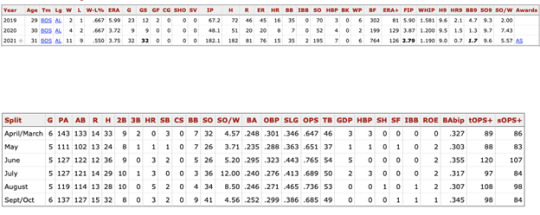
He led the AL in games started, led the AL in FIP, and led the majors in BB/9.
His April/May were unsustainably good, specifically the one home run he allowed over eleven starts, but he’s done an excellent job of limiting walks and throwing strikes. He averaged 16.1 pitches per inning this season, and batters were only ahead in the count ~21% of the time this year. Eovaldi is a flamethrower -- he throws his four seam fastball roughly 42% of the time and it sits at 96mph -- doesn’t have a lot of spin (29th percentile) or vertical movement (10% less drop than average) but it does have 46% more horizontal break (12.2 inches of horizontal movement) to the four seam. He also mixes in a slider vs righties (13.7% of pitches thrown and has average movement) and a curve vs lefties (18.8% of pitches thrown and also has average movement.) Neither pitch gets hit a lot but when the slider does get hit it’s usually for extra bases. He’ll also mix in cutters and splitters -- the splitter is an out pitch and gets a good amount of strikeouts, the cutter is a bad pitch that should get hit hard.

That is his pitch chart from his most recent start against the Yankees.

And the chart of when he’s throwing his pitches -- now it’s a good thing for him that he’s getting ahead in the count, because you can see that when he is behind, he’s essentially only throwing fastballs. When batters ARE ahead in the count, they’re slashing .280/.414/.527 against him, which is actually well below MLB league average. He also really struggles the third time through the order:

So I would assume that Eovaldi goes 4, maybe 5 innings before being pulled for the bullpen.
Nathan also has been significantly worse vs right handed hitters than vs lefties:

And importantly, has already faced the Yankees six times this season: going 2-2 with a 3.71 ERA in 34 innings -- giving up 38 hits, five home runs, four walks, and striking out 34 batters. That’s a .279/.310/.434 slashline for the Bombers.

Now, when the Red Sox do end up going to the bullpen, they’ll have a lot of right handed relief options to go to: Garrett Richards, Garret Whitlock, Hirokazu Sawamura, Adam Ottavino, and Matt Barnes. The Sox ended the season with the 13th best bullpen ERA, but the 23rd best bullpen WHIP -- so they’ll let guys on base.
Garret Richards was legitimately bad as a starting pitcher this year, but a move to the bullpen may have revitalized his career:

He was a guy with two decent pitches -- a four seam fastball and a slider, and by moving to the bullpen he’s been able to increase his fastball velocity and not have to worry about showing other pitches. He still has the 12-6 curve he can pullout in emergencies, but he’s not having to throw a near eephus pitch a couple times an inning just to give guys a different look.
Garrett Whitlock is in an interesting situation -- he was one of the best stories in baseball this summer and was looking like one of the best relievers in the AL…until he wasn’t. He started to get hit around a bit in May, and then in September started to really struggle, but its hard to know how much of it is him, and how much of it was his injury. He went on the IL on September 21st with a pectoral strain, but he was activated before the final game of the season for the Red Sox, so it’ll be interesting to see if Cora throws him into the fire with no rehab appearances on Tuesday.
Old friend Adam Ottavino was doing well for the Red Sox this season (if you ignored the lefty/righty splits for the first half of the season) until this September, where in his last 13 appearances he’s given up a 1.152 OPS against and a 7.36 ERA. So yeah, typical Otto!
Lastly, Matt Barnes also had a dominating first half of the season before falling off a cliff after the trade deadline, and has a 6.48 ERA since the All Star Break.
Red Sox Lineup

The good for Boston- this offense is really, really good from top to bottom. The bad for Boston -- JD Martinez sprained his ankle running to the outfield during the last game of the season and Alex Cora said he’s questionable for the Wild Card game. They can just play both Schwarber and Dalbec if that’s the case, but if he does miss the game it would be a huge loss. The other bad news for Boston -- they’re literally the worst team in baseball at fielding. Boston’s defensive efficiency was at .659, meaning that roughly 66% of balls put into play ended up being outs. The next worst team were the Angels at .680, and the Red Sox committed more errors than anyone other than the Marlins. According to Statcast’s Outs Above Average, other than Enrique Hernandez in CF, every Red Sox player was either neutral or bad defensively this season. They have some good arms, especially Hunter Renfroe, but this is a bad defensive team that the Yankees should hopefully take advantage of (Devers and Bogaerts especially are beyond awful.)
That said, as bad as Bogaerts and Devers are defensively, they more than make up for that offensively:

Devers in particular has become one of the game’s best hitters, and might be the best hitting third baseman in the AL.

And Bogaerts is no slouch either, putting up a monster year of his own at shortstop.
This is a team that also hit Cole hard, and if JD Martinez is able to play, then I’d expect them to start Schwarber at 1b and then use Dalbec as a pinch hitting option late as a counter to either Luetge or Wandy or Chapman. I’d also expect them to call up Jarren Duran, one of the fastest players in baseball, to use as a pinch runner late if they need to.
Fenway Park

It’s a major hitter’s park -- its currently the second most favorable hitter’s park (behind Coors Field) over the past three seasons, and that’s with it being a below average park for homers. Expect lots of doubles and triples and singles here due to the wonky dimensions and fences. It’s also the #1 left handed hitter’s park.
Yankees Offensive Keys to Success
Make Eovaldi work and get behind in the count, letting them tee off on his fastballs
The lefties have to do work -- whether thats Gardy or Rizzo or Gallo or Wade or Odor or Velazquez, a couple guys from that group have to punish the purely right handed bullpen of the Red Sox.
When the Red Sox let our guys get on base, the team has to take advantage of it -- whether its through stealing bases or productive outs or just not grounding into a double play right away.
Someone other than Judge and Stanton needs to carry some of the load offensively and get a big hit
Yankees Defensive Keys to Success
Cole needs to get through the first inning -- over the course of the season he allowed a .839 OPS against and a 4.80 ERA against in the first inning, and he allowed almost a third of his home runs in the first inning. Get past that first challenge by Devers and he should be good.
Don’t be afraid of giving up the long ball -- it’s better to attack this Boston team and give up some damage then nibble around them and have the big hits count for more than one run. They’re going to get theirs, it just comes down to whether its a couple solo shots or a couple three run bombs.
Don’t worry about the steal -- other than Duran (who’s in the 96th percentile for sprint speed) this is a really slow team that stole the second least amount of bases in baseball. If someone gets on, don’t be overly worried about the runner and get distracted, just focus on getting your outs.
Please catch your pop ups.
Prediction Time
I’m going to say Yankees win this 5-3, mostly because I trust the Yankees bullpen more than Boston’s at this point. If the Red Sox bullpen was clicking like it was in April and May I’d feel differently, but especially in a Wild Card game where starters rarely go more than five innings, it’s just a lot to ask of this Boston bullpen to be able to give good length.
#Yankees#Red Sox#New York Yankees#Boston Red Sox#Fuck the Red Sox#MLB Playoffs#MLB Wild Card#MLB Postseason#David Ortiz Did Steroids#He Is Still Getting to the Bottom of It
1 note
·
View note
Text
Mid-Season Report Card: Infielders
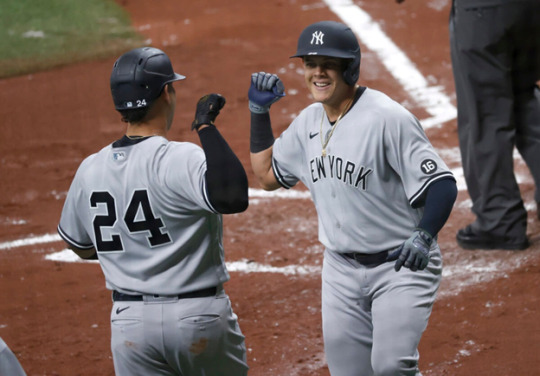
Jay Bruce: F

Not to speak ill of the recently departed, but man Bruce was terrible. He was a disaster at the plate, and worse at first base.
Mike Ford: D-

Ford also stunk at the plate, but he was at least a good defensive first baseman and has been killing it in Triple A this season, so maybe he’ll get another call up with Tampa or with another team in the future.

Chris Gittens: F
Gittens was the apple of the fans eyes’ when the Yankees were having major issues at first base, and he was called up and looked like a AAAA hitter. He’s been good in the minors this year, but Chris has been “Not So Hard Hittin’” in the majors—only three of his 28 at bats have featured a hard hit ball.
Kyle Higashioka: B-

Higgy had taken away Gary’s starting spot (again) after a hot start to the season, but after putting up 22 total bases in April (in 37 plate appearances), he’s put up only 21 since (in 67 plate appearances.) He’s been Cole’s personal catcher (and was Kluber’s before the injury), and despite his struggles at the plate, he’s still clearly the better defensive choice behind the plate- he’s sixth in extra runs saved with his framing (-3 runs better than the average catcher) and fifth in strike rate (51.9% of chase pitches are framed as strikes.) He also has the 8th best pop time in baseball at catching runners stealing bases. Here’s his framing chart by zone, and you can see why pitchers love throwing to Higgy:

At the plate, Higgy is a mixed bag. He’s got major platoon splits—.162/.240/.353 against righties, and .276/.364/.621 against lefties. He’s crushed fastballs this year again—.250 BAA and .571 SLG against fastballs, and can take fastballs up and in yard with ease, but he’s 3-36 against breaking pitches this year. Overall I’d say this has been a positive season however for Higgy—he’s clearly proven he can be at the very least a backup catcher on a good team.
DJ LeMahieu: C-

DJ (at the time of this writing) is currently on a 30 game on base streak, which is obviously nice. Not so nice however, is the massive drop off in slugging. DJ has the second biggest drop off in SLG% from 2020 to 2021, and unlike some of the other guys near the bottom (like Juan Soto for example), it doesn’t really feel like it’s a fluke that it’s dropped off this much. Obviously being able to play three positions really well defensively and being able to stay healthy is a huge boost to the team, and even if DJ is under contract for a while, his contract isn’t anything that will necessarily hold the team back, but a .363 slugging is really bad. Also really bad:

Even when DJ was a MVP candidate, his numbers on pitches in the heart of the plate weren’t amazing or anything but DJ is tied for fourth worst in baseball at pitches right down main street. Another huge issue for DJ has been the fact that despite being someone who’s going the opposite way a lot, he’s been miserable on outside pitches:

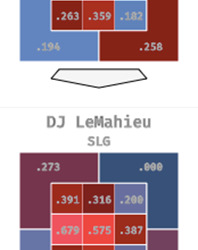
The inability to actually drive anything the opposite way and the inability to take advantage of meatballs and high pitches to do damage is really shocking. He’s had thirteen extra base hits in 290 plate appearances since May. I’m pretty sympathetic to DJ having to move all over the place defensively, and I do think he’ll rebound, but I think he’s more likely to rebound to a .300 or .310 batting average than a .450 or .500 slugging percentage. At this point he might be what he is, which is someone who gets a lot of singles and plays good defense, but if he can’t drive the ball and continues to be mediocre on the base paths, then I think he would be better suited to be dropped in the lineup.
Rougned Odor: B+

For someone the Yankees got for cheap and don’t have to pay his contract for, I think he’s been a lot better than anyone could have ever hoped? I’m not sure he’s actually good, but at this point he’s been one of the best hitters on the team (which I think says more about the rest of the team than Roogie) and he plays pretty good defense at second base and has stayed healthy. He has a tendency to come through in tough spots, and he’s actually had crazy reverse splits this year (despite being a traditional splits guy before this year.) Roogie is slashing .206/.281/.373 against righties, but an incredible .271/.352/.625 against lefties, mainly because he is crushing breaking balls away, and stuff low and inside, against lefties. He’s been worth +6 runs against sliders so far this year! Here is his xwOBA on balls he makes contact against lefties:
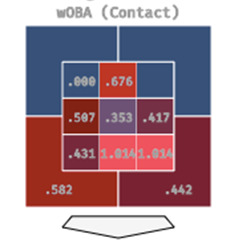
Obviously he’s still striking out a lot, but his strikeout rate is down 5% this year and his walk rate is up 3%. He’s also drastically increased his pull rate (56.6% is 11% higher than his previous high) which helps to increase power, especially when there’s a short porch in right.

To be honest, it’s hard not to be impressed by Odor’s comeback this season.
Gary Sanchez: B+

I wish I could break this down as something more like “Gary Sanchez from the end of May through June: A+, the rest of Gary’s first half: F”, but overall I’ll give him a B+. Last year was such a dumpster fire that the Yankees weren’t sure if they were going to tender him a contract this year, and then the start of the season was just a continuation of that trend and Gary lost his starting job again. June however, was a different story—the Kraken slashed .289/.372/.663 as Gary was Scary again, and back to the All Star level player at the plate we’d seen before.

It’s just hard to know if that was “Gary is back!” or if it was “Gary had a really hot five weeks”, because outside of that stretch, he’s looked pedestrian again at the plate. In positive news, his walk percentage has increased (his 13.3% BB rate is in the 90th percentile), his strikeout rate has dropped 9%, and his overall numbers have increased year over year. He’s done this by barreling the ball less and hitting the ball slightly less hard on average, but if you look at his percentile rankings, he’s essentially been the same player this year as he was in 2018:
Defensively, Gary’s been awful again, and at this point I’m not sure why they keep switching catching coordinators on him because I don’t think there’s anything he can do to change his ineptitude behind the plate. He’s 51st in framing (out of 59 qualified catchers), he’s 108th in Total Zone Catcher Runs Above Average (out of 109 qualified catchers), has the 9th most passed balls allowed (a major improvement unfortunately), and despite having the 7th best pop time of any catcher, he’s only caught 8% of baserunners (80th.)
Gleyber Torres: D+

Earlier I talked about how DJ’s numbers don’t feel fluky—he looks and has been playing like someone who shouldn’t be getting a ton of extra base hits and doesn’t seem to have any mechanical issues going on, Gleyber is the opposite of that. He’s very clearly had some mechanical issues, and they’ve really sapped him of his power—.328 slugging is downright atrocious, and having a lower slugging than on base percentage is terrible. He’s been tied for the second worst player against four seam fastballs this year:

This is a guy who in 2019 was +14 runs against four seamers when he hit 24 bombs off them. That said, I do think there’s a couple issues at play here: obviously the mechanics are a big problem, and it sounds like he’s gotten them fixed. He’s been off balance a lot, and his hips have been moving way too much on his swings, both of which will really sap your power and cause you to mishit the ball (hence Gleyber being in the 8th percentile for average exit velocity). The other issue is that after getting criticism for swinging at too much, he’s become too patient at the plate- his walk rate continues to increase, his strikeout rate continues to decrease, but he’s not driving the ball in the heart of the plate anymore (which is seemingly a problem amongst all the Yankees hitters.)
Defensively, he’s bad at shortstop, but we all knew that. He’s been especially bad at getting to balls that he has to move forward on, and balls hit to the third base side of the field- fourth worst at balls in (-3 runs) and fifth worst at balls hit to third base (-7 runs), but actually second best (+5 runs) against balls hit towards second base. He just doesn’t have the speed or range to cover balls hit in, and doesn’t have the range to get to balls that he has to dive to his non-glove side. It’s not disastrous to the point that you have to move him off shortstop yet, but it is getting close.
Overall I still have hope in Gleyber—I think he’s shown some signs of life the last couple weeks, and if he can start to drive the ball again, then you have someone who is a Top 25 player in baseball. If he can’t figure it out, then the Yankees future is in big trouble.
Gio Urshela: A-

Another ho-hum season for Gio, his overall numbers are down but he has been playing through a leg injury for almost two months now. This year he is once again crushing fastballs—.327 BAA and .566 SLG against, but has really struggled against breaking balls—.186 BAA and .245 SLG against. Leg injuries can really impact your ability to get to outside pitches and to create hard contact, both of which have been issues for Gio this year—his strikeout rate has doubled and his walk rate has been cut in half, and his average exit velocity is down 2mph. He’s also been chasing at a lot of pitches (34.6% chase rate is 9% higher). I think if he was healthy you wouldn’t be seeing those issues, and the fact that he’s playing on one leg and has been our second best position player is nuts.

Defensively, he’s a monster despite the injuries. He’s in the 79th percentile in OAA, and despite not being a shortstop and being injured, he’s been worth +2 runs at shortstop:
We should all be thankful for the fact that we have Gio on this team, because he’s been one of the few bright spots in the lineup.
Luke Voit: F

Is this harsh? Maybe. But the fact of the matter is that Voit, the little amount of time he’s actually been healthy, has not been good, and he is currently on the IL for the third time this season—two of which are knee injuries, the first of which he got being stupid for no reason in a Spring Training game. Would he have gotten that injury if he wasn’t being dumb? Maybe, but the other Yankees first basemen have been disasters and he’s not been much better.
Tyler Wade: F

Wade can’t hit, he doesn’t walk, he’s only attempted six steals and been caught twice, outside of being fast I’m not sure why he’s on the team.

Yes, it’s nice that he can play six positions defensively, but he’s average at all six. He can’t hit. Take him out to pasture and move on.
#Yankees#new york yankees#midseason report card#infielders#luke voit#gleybae#giodude#el gary#Le Machine#BIG HIG#roogie#tyler wade is the bum to end all bums#he is the ur-bum
0 notes
Text
Mid-Season Report Card: Relievers

Albert Abreu: B+

After being pretty bad in spring training in a likely make-or-break year for Abreu, he’s ended up actually performing pretty well! I’m not sure how sustainable he is—is he effectively wild or just lucky? But in his last four appearances he’s given the team some actual length out of the bullpen and given guys some rest:

He’s moved to a sinker/slider approach with a four seamer and changeup that he’ll mix in against lefties, and found some really good success with it. Throwing a 97mph sinker is really nice, and since his slider doesn’t have a ton of break to it, it’s almost like a change-up breaking away from righties. The big issue with Abreu is, and always has been, his pitch location, which isn’t exactly great, but he’s starting to look like an actual big league reliever. I really hope they give him some more looks the second half of the season.


Zack Britton: Incomplete
Honestly you can’t really blame Britton—he had COVID right before spring training and lost a bunch of weight and strength, then got elbow surgery, then when he came back had an injury scare, then got actually injured a couple days after that. He’s had barely any time to pitch or get loose or anything, but he’s looked fine when on the mound considering he’s basically in Spring Training mode right now.

Luis Cessa: A-
Cessa has continued to up his slider usage—his 60.6% slider usage is 17th in baseball—which has really helped to hide his mediocre fastball. Opponents have gone from hitting .306 with a .494 SLG against his fastball in 2019 (when he threw his fastball 34% of the time) to .192 with a .231 SLG this year (when he’s throwing it 20.3% of the time.) He also hasn’t allowed a single baserunner against his change-up this season, which he throws exclusively against lefties. His slider has gotten hit more, but it’s still been a really good pitch and he had room to give up a few more baserunners if it meant hiding his fastball more. Cessa has also tinkered around with his slider over the past few years:
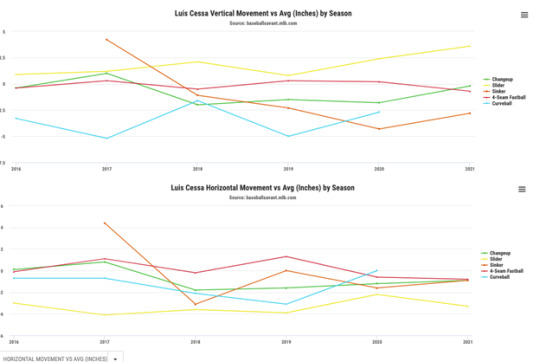
His slider’s horizontal movement has stayed roughly the same (despite the rest of the league going more and more towards the wipeout slider) and instead he’s been getting more and more drop on his slider—over 4 more inches of drop in 2021 than he had in 2019 for example. Lastly, he’s Cessa by leverage situations:

The tougher the spot, the better he is. Let Cessa cook.
Aroldis Chapman: D+
As bad as Chapman’s been the last few weeks, his first month and a half of the season was one of the best runs a reliever has had in the history of the sport.

That said, the last couple months have been just atrocious from Chapman.

I’m not sure if it’s the finger nail, or if it’s the lack of sticky stuff, or what the issue is with Chapman, but his velocity is down almost 3mph, his spin rate has dropped a couple hundred RPM, and he’s not getting nearly as many swing and misses. Honestly, the worst thing that’s happened to Chapman is just the fact that he’s completely lost the zone—he’s still in the 94th percentile in xBA against, but when he misses, he misses badly, especially against righties:

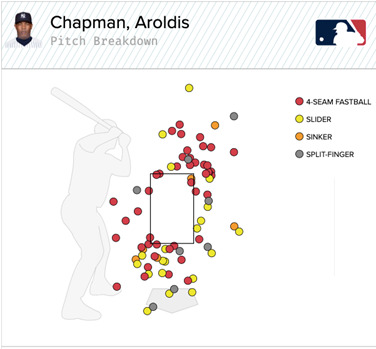
It’s just too easy to take on him right now when he’s missing the zone completely, and Chapman’s stuff is thrown so hard that if you make contact it’s too easy to hit homers off him. He’s still in the 2nd percentile in strikeout rate, but he’s in the bottom 2nd percentile in walk rate. It’s just too bad that this is going to make everyone forget about how dominant he was in April and May, but he fell off a cliff the same time the rest of the team did.
Nestor Cortes Jr.: A

Potentially the savior of the 2021 Yankees? Nestor has been mixing in a ton of junk, but his pitches do have a bunch of movement to them—his fastball has elite vertical drop and his curveball has elite horizontal movement. His average exit velocity is 85.8 mph, which (if he had enough qualified batted balls) would be top 10 in baseball. He’s obviously most famous for his wonky deliveries and locations:
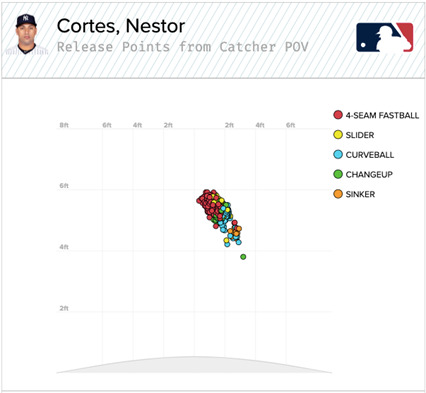
Normally a poorly repeated delivery leads to control issues or telegraphed pitches, but when you’re over the place as much as Nestor is and throwing all sorts of different junk all over and around the plate, it ends up being effectively wild. He’s working at three distinct speeds and has movement going left and right with his pitches as well as up and down, so it’s just an awkward guy to face. Do I think he’ll keep it up? Probably not, and he’s a guy that if he’s off then you’re going to murder his pitches, but I’m enjoying the run he’s on right now.
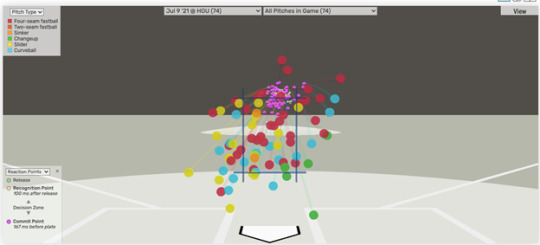
Chad Green: A-

Goose has been almost everything you could have hoped again this year—it’s easy to remember the bad moments with him (and there’s been some really bad moments), but he’s been one of the best relievers in all of baseball again this year, especially for a multi-inning guy. I mean, look at his percentile rankings over his career:

Yeah, when he gives up contact, it’s hard contact, but he peppers the strike zone, his fastball has really good movement and spin, and moving from a slider has really helped his career- his curve actually has less movement than the average curve, but it comes in the same location as his fastball and drops enough (and around 10mph slower) that it’s hard to keep up. So yeah, he gives up hard contact, and he gives up some homers (he’s actually given up almost as many XBH as singles this year) but he’s not walking guys and not giving up much contact, and that’s over two or three innings at a time. Great job this season Goose.
Brooke Kriske: F

Honestly not sure what he’s done to earn a spot on the 40 man, let alone stay on the 40 man, but he’s bad. He’s been bad in AAA, he’s been beyond awful in the majors, just move on from him.
Jonathan Loaisiga: A+

Lasagna’s fifth in fWAR among all relievers with 1.7 fWAR out of the bullpen. Here are some of his percentiles:
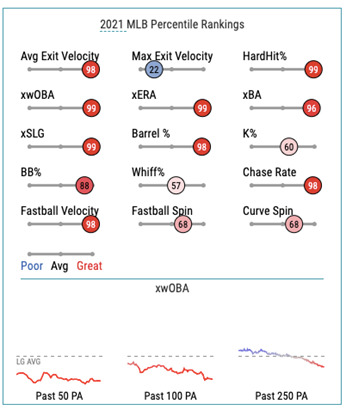
Lasagna is really, really, really good. The big change for him is going from throwing a 98mph four seam fastball with limited movement in the first few years of his career to throwing a 98mph sinker with a lot of movement this year. He’s just absolutely dominating opponents: his sinker is worth -8 runs, making it one of the best individual pitches by a reliever this year- up there with Devin Williams’ change up, Emmanuel Clase’s cutter, and Adam Ottavino’s slider.

He’s not getting a ton of strikeouts, but guys are chasing a ton of his pitches (37% chase rate) and making contact on those chase attempts (61.4% contact) which has given him -14 runs compared to the average pitcher in the “shadow” region (borderline strikes.) Having guys hitting those pitches is how you get Top 2% in both barrel % and average exit velocity, and it’s how you get a 65.3% ground ball rate. The best part? This is definitely repeatable. It’s not like he’s getting fluke results, if anything he can continue to improve by working on increasing his strikeout rate. Lasagna is, in my opinion, the best surprise in the first half of the season for the Yankees.
Lucas Luetge: A-

Considering he’s been out of the majors for six years, its hard not to be impressed by what Luetge’s done.
Fastball is slow, but it has a lot of spin, and his curveball is elite—above average in both vertical and horizontal movement. More impressively, he’s done a great job of saving it as an out pitch, and so far this season he’s finished 28 at bats with it- and players are 0-28 with 23 strikeouts and no walks. His slider on the other hand has not been good—players are slugging .629 off the slider, and he uses that significantly more than the curveball. He may want to consider dropping the slider and going heavier on the curve.

Luetge’s season has also been a strange one—gave up runs in each of his first five appearances, then went ten straight appearances without allowing a run, then went another stretch without giving up runs, but the last couple weeks have been a little rough. Hopefully he can get back in a groove and continue pitching well in his Cinderella season.
Nick Nelson: F

He’s bad.

This is how you get a nearly 18% walk rate and how you allow hitters to hit nearly .500 on you fastball. He has a higher upside than Kriske, but I also don’t get why he’s on the 40 Man roster. The idea behind him is that he can give you a couple innings out of the pen, but when he’s walking every other guy and giving up hard contact to the other one, you end up with Nick Nelson.
Darren O’Day: D-

When healthy he’s been good, but I don’t think getting 12 starts out of him over the course of the full season is what Cashman was expecting when he signed him.
Wandy Peralta: D+

Wandy’s first month or so in Pinstripes: really good! Since that point: really bad!

His change up has been stellar—.128 BAA, .213 SLG against, with a really nice whiff rate and low exit velocity against. Everything other than his change up is awful- opponents are slugging an insane .867 (which is actually really lucky for Wandy as the xSLG is .952) and they’re hitting a whopping .481 against his slider. I think it’s fair to call this a lose-lose trade for the Yankees and Giants.
Justin Wilson: F

I feel bad for Wilson—he signed with the Yankees just at the start of spring training, then was delayed because of the storms in Texas, then got injured, then rushed back, then got injured again, but overall—he’s been awful in his return to Pinstripes. Ultimately, when you throw either a four seamer or a cutter 96% of the time, and opponents have a .359 BAA and .821 SLG against your four seamer, you’re pretty much washed as a pitcher.
#yankees#new york yankees#relievers#nick nelson#luis cessa#some dude named aroldis chapman#midseason report card
0 notes
Text
Mid-Season Report Card: Starting Pitchers

Gerrit Cole: B-

As bad as the last month has been, he’s still maybe the AL Cy Young frontrunner? He’s leading the AL in strikeouts and strikeout to walk ratio, his 3.6 bWAR is second among AL pitchers (behind Kyle Gibson), and he’s in the top 10 in almost every major category. The elephant in the room is clearly the “sticky stuff” issue:

Obviously his spin rate is down (fastball in June was 400rpm lower than April) but he’s also had some mechanical issues since the crackdown, and either the lack of sticky stuff effecting his fastball or the book being out on it more has led to his change up falling off a cliff:

He’s also increased his fastball usage with two strikes and is throwing more fastballs in the strike zone with two strikes since the crackdown. I still gave him a B- because if you looked at his overall stat line you’d be thrilled, but I think there are obviously concerns about what Cole is like without the advantage of additional substances. He’ll still be good pitcher without it, but at the very least there’ll be a learning curve for him.
Domingo German: C+

Considering he missed an entire season (due to his own issues) the fact he’s been essentially the same pitcher that he was in 2019 is pretty remarkable. He’s really run into a few issues (unsurprisingly, the same issues he’s had throughout his career):

Like a few of the guys, he’s sucked the first time through, and has gotten better the deeper he goes in games.
He’s also been garbage in the Bronx, giving up 13 homers in 37.2 innings.

Lastly, his curveball has actually been really good! But his fastball has been awful.
I think you’d take this season from Domingo since he hasn’t pitched in a year and a half, and he hasn’t been the biggest issue in the rotation, but at this point I think Domingo is who he is. I’d also expect him to start performing worse considering it was the end of July in 2019 when he got tired and his stuff fell off a cliff, and I can’t imagine he’s going to be good for 180 innings this year.

Corey Kluber: D-
Kluber was good this year when he pitched, but he once again got injured. Yes it’s cool he threw a no hitter and was one of the better pitchers in baseball in May, but none of that is really going to matter since he will unlikely pitch a big game for the Yankees this year.

Mike King: B

King as a reliever—really good! King as a starter—really bad! Overall, pretty solid season for him so far.

His big issue as a starter is the fact that he has stunk starting the game off. He’s talked about how he wants to change his approach to start off games because he’s giving off less looks early in games to set guys up for later, but he’s been throwing batting practice in the first inning:

Overall, for someone that’s not really that great, he’s at least earned a role with the team and may end up getting to the 100 innings he wanted to pitch this year.
Jordan Montgomery: C-
Jordan’s been good at home, bad on the road, but considering he’s two years removed from his Tommy John surgery, I really wished that he would make a step up this season to the promise he had as a rookie, but at this point I think it’s fair to say Gumby is who he is.

The home stats are great, the road stats are not so good. He’s allowing a low exit velocity (87mph) and is in the 65th percentile in xOBP, but I think at this point he is what it is, which is a fifth starter.

His fastball and cutter are really bad. The change and curveball have been great, and he’s done a good job pitching backwards, but the fastballs are just awful.


Jameson Taillon: C-
Taillon’s overall numbers don’t look great, but considering he missed nearly two years, there’s some promising stuff in there. The big issue for Jamo is that he has been awful the later in games he pitches:

There’s two issues he’s running into there, one of which is worrying and one is fine — the first issue is that he’s just missed so much time and is just building himself back up. This year was always going to be a build-up year, with the hope that in 2022 he’d be a good #3 option for the team. The worrisome issue is that he’s essentially a two pitch pitcher without any other looks he can give guys, which is also leading to him getting crushed the second and third time through the order:
If he can’t get a third pitch to use against lefties and righties, then he’s probably destined to a bullpen role.
0 notes
Text
Red Sox (33-23) at Yankees (31-26)

Friday – 7:05pm on YES and MLBN: Nathan Eovaldi (6-2, 4.01 ERA) vs Michael King (0-2, 2.86 ERA)
Saturday – 7:15pm on FOX: Eduardo Rodriguez (5-4, 5.64 ERA) vs Jameson Taillon (1-4, 5.10 ERA)
Sunday – 7:08pm on ESPN: Garrett Richards (4-2, 3.75 ERA) vs Domingo German (4-3, 3.27 ERA)
Boston Pitching
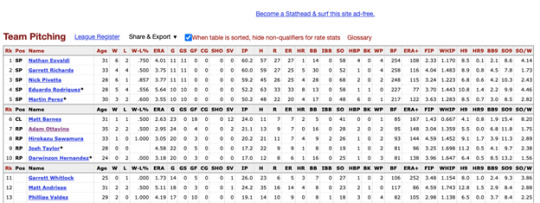
The Red Sox come to the Bronx with the 12th best ERA+ in baseball (110), thanks in part to allowing the fewest homers in the league (.7 home runs/game allowed.) While none of their starters jump off the page at you with their numbers or their stuff, they’ve been able to do just enough on the mound to get the Sox to a winning record. They actually have the second lowest FIP in the league (which is fielding independent pitching) thanks to a low homer rate but a decent amounts of hits allowed (8.5 hits a game allowed) but have left the fourth most batters on base. They also have the worst defensive efficiency in the majors—only 66% of balls in play end up as outs, and they have the fourth worst outs above average allowed with -11 OAA and an additional 9 runs they cost themselves. Their outfield isn’t terrible: -2 OAA defensively, but the infield is a disaster at -9 OAA. This could play into the Yankees hands as they’ve been known to hit a lot of grounders.
Starting the first game of the series is a very, very weird statistical case in Nathan Eovaldi. Eovaldi has bounced back the last couple years to be the above average pitcher he’s typically been, but it’s been done in a really weird way. His HR/9 has gone from 2.1 in 2019, to 1.5 in 2020, to .1 HR/9 in 2021, despite throwing his four seam fastball nearly half the time right down the pipe.
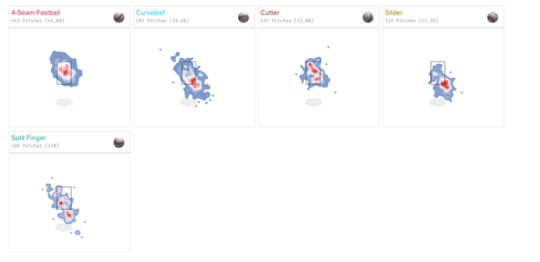
He throws a 97mph four seamer with a ton of horizontal break (49% more horizontal movement vs the average four seamer) and mixes in a slider vs righties and a curve against lefties, but despite having really good stuff, he rarely gets strikeouts (39th percentile in strikeouts) and rarely gets swings and misses (32nd percentile in whiff rate.) So you have a guy with really good stuff that hitters are teeing off of, but not hitting homers: he’s allowed the fewest homers in the majors (1) of any qualified pitcher, but has allowed the 36th most singles (36), the third most triples (3), and the third most doubles (17). His platoon split this year is also way below his career norms—lefties this year have a .565 OPS, which is over .200 points lower than his career numbers, almost entirely because people stopped hitting his curveball (.121 SLG against this season is over .500 points lower than in 2019.) Boston is a good team, and this season they’re having isn’t a fluke, but I’d wager that Eovaldi’s season has been a fluke.
On the flip side, Game Two starter Eduardo Rodriguez has had some brutal luck this year. After missing last year due to myocarditis complications from the coronavirus, E-Rod has pitched to a 5.64 ERA, but his xERA is 2.93. He has a BABIP allowed of .374 which is the worst in the majors of any pitcher who’s pitched 50 innings.

E-Rod is a guy that throws mostly straight pitches—he has a four seamer that sits around 92mph, a cutter with less movement than normal, a decent change up, a sinker, and then every once in a while he’ll mix in a slider. The fastball has been a good pitch for him this year, but his change up and cutter are getting put into play too much (seven extra base hits in 29 balls in play for his cutter this year.)
Garrett Richards is starting Sunday night, and after his career was mostly derailed from injuries, the once-promising starter has turned into a perfectly acceptable middle of the rotation guy. He’s really a two pitch pitcher—fastballs and sliders against righties, fastballs and curveballs against lefties, and his stuff features a lot of vertical drop- an extra 5 inches of drop on the slider, and an extra 10.6 inches on the curveball. He gets a ton of spin on the fastball and the curve (95th percentile on fastball spin rate and 100th percentile in curveball spin rate) which would be super awesome if he could actually locate his pitches. He only strikes out 20% of batters he faces, and walks 12% of hitters he faces, and it doesn’t matter how much spin or movement you have on your pitches when your heat map looks like this:
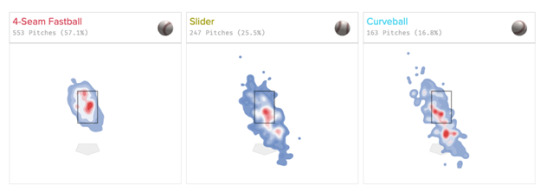
Also, in Richards’ career vs the Yankees: 0-5 with a 8.42 ERA, 1.20 K/BB ratio, and Yankees hitters have a .870 OPS against him in seven starts. Between the three starters and the bad defense, this might be a chance for the Yankees bats to wake up.
Since I’m sure people are wondering as well, a quick dive into Adam Ottavino this year—still awful against lefties, but has been really good against righties (.087/.263/.109). Allowing some of the weakest contact in the majors but also walking a ton of guys as well. He’s basically having the same level of success as he did at the end of the 2019 season, and I’m sure he’s going to make the Yankees look silly this weekend since our lefty options are Gardy, Wade, and Odor.
Boston Hitting
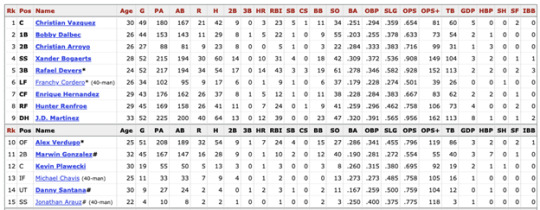
After a shockingly bad 2020 season offensively, the Sox are right back to being a good offense—they’re 7th in OPS+, thanks to having the third best batting average in the league. They don’t walk ever (second to last in walks) and are right around league average in strikeouts and home runs, but they put the ball in play and get a ton of doubles—they have 16 more doubles than the second place team does and nearly twice as many as the Yankees do. Boston has been getting by with a stars and scrubs approach however—the top guys in their lineup (JD Martinez, Devers, Bogaerts, and Verdugo) have really been carrying the load for their offense.
After an awful 2020 season, J.D. Martinez is back to his normal destroyer of worlds self. He always mentioned that the pandemic was really messing with him mentally, and this year he’s been perfectly fine—162 OPS+ is right in line with his previous All Star seasons going back to his days in Detroit, and really anything in the zone is getting hammered.

Best bet with him right now is to pound everything low and away and throw in the occasional inside heater, especially because he has a high chase rate (15th percentile.) He’s been worth 17 runs above average on pitches in the zone, which is second in the major leagues behind Vladito, and he’s near the tops in every hitting category. The Yankees are going to have to be ready to get through the top of the order and have their best relievers ready to deal with them.
#New York Yankees#Yankees#Boston Red Sox#Red Sux#Fuck Boston#Fuck Altuve#Alex Cora is a cheater#Boston is a dumpster city filled with trash people#Sorry AJ it's true
1 note
·
View note
Text
Yankees (29-21) at Tigers (19-31)

Game 1 - Friday at 7:10pm EDT on YES – Gerrit Cole (6-2, 1.81 ERA) vs. Casey Mize (3-3, 3.42 ERA)
Game 2 - Saturday at 4:10pm EDT on PIX 11 and MLBN – Deivi Garcia (0-1, 4.50 ERA) vs. Spencer Turnbull (3-2, 3.12 ERA)
Game 3 - Sunday at 1:10pm EDT on PIX 11 and MLBN – TBA (Michael King/bullpen game) vs. Tarik Skubal (1-7, 5.23 ERA)
Tigers Injury Report
C Wilson Ramos: 10-day IL (back) – will miss series
C Greyson Greiner: 10-day IL (hamstring) – will miss series
RP Erasmo Ramirez: 10-day IL (pectoral) – will miss series
SP Jose Ureña: day-to-day (forearm) – will miss series
SP Julio Teheran: 60-day IL (shoulder) – will miss series, due back next month
Tigers Pitching
The Motor City Kitties are still steeped in the middle of a total rebuild and their play this year reflects that, as they sit in last place in the AL Central with a 19-31 record. They have been better of late, though (10-7 since a 9-24 start), and more importantly, their rotation has been a verifiable success story: their starting pitchers have combined for a 3.94 ERA this season, good for 5th in the American League and ranking ahead of contenders like Boston and Oakland. A mix of improving veterans (Spencer Turnbull, Matthew Boyd), graduating prospects (Casey Mize), and “one man’s trash is another man’s treasure” signings (Jose Ureña) have come together nicely to give the Tigers reliable quality innings (and, potentially, some ammunition for the trade deadline as they attempt to continue building up their farm system):

24 year-old RHP Casey Mize faces the unenviable task of going toe-to-toe with Gerrit Cole in the opening game as the Yankees will get their first look at the Tigers’ 2018 #1 overall pick. Mize has long been considered a very polished prospect with a diverse repertoire. As expected, he cruised through the minor leagues and made his Tigers debut last year. He struggled through seven major league starts in 2020 (6.99 ERA) and got off to another slow start this year (5.06 ERA in April), but has seemingly started to put it together in May (1.73 ERA), including a 6 IP, 3 H, 1 ER performance against a tough Red Sox lineup in Fenway on May 5.
Mize’s fastball hovers around 94-95 mph with middling spin; he plays it off a sinker and split-finger to get ahead in counts, and then throws a slider and curveball to try to put batters away. None of his pitches are particularly dominant, and thus he has not struck out a whole lot of guys; his path to success lies in his unpredictability and variety. He mixes in all of his pitches in all kinds of spots and counts to both lefties and righties, and picks up a lot of weak contact in the process:


Mize has walked more guys than one would expect of someone of his archetype, but that could be attributed to him recently reaching the majors and still figuring things out; he has always been known for having very good command and I expect him to rectify the walk issues moving forward. Nevertheless, the Yankees can and should attempt to drive up the pitch count and get free passes off him, because barreling up his pitches may prove difficult for the lineup they’re trotting out there (right-handed batters have posted a .199/.286/.321 line off Mize in his short time in the majors).
Spencer “Yes, Even I’m Throwing No-Hitters These Days” Turnbull will start the middle game of the series, and is having a very good season as he continues to grow as a pitcher with each passing year. Like Mize (and the rest of the Tigers pitching staff which ranks 14th in the AL in strikeouts), he hasn’t been racking up whiffs, but he’s been doing an awful lot of good stuff otherwise:

Turnbull was another polished, well-regarded prospect (2nd round pick in 2014) who was never expected to become a top-of-the-rotation ace due to his lack of strikeout stuff, but has nevertheless developed into a great piece for the Tigers because he locates his fastball really well, has good spin on his pitches, and rarely walks guys or gives up homers. He had already been discussed as a potential trade centerpiece as early as last season, and his strong performance in 2021 – especially after the no-hitter – has only intensified the rumors. He turns 29 in September so he’s not a young up-and-comer perfectly aligned with the Tigers’ rebuild timeline, but Detroit does still have him under team control through 2025, so it would presumably take a blow-you-away kind of package to pry him away from them at this point.
Tigers Lineup

While the pitching has looked promising, Tiger hitters have shown few signs of life this year:
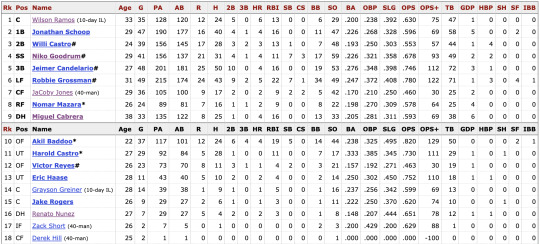
The Yankees got a taste of the Tigers’ attempt at an offense last month, and the result was four Detroit runs in three games. Things haven’t been much better for them since; they remain a mishmash of AAAA guys and scrap-heap veteran signings (Ramos, Schoop) that have not shown much of anything, and the Yankees should consider themselves lucky to have run into them while in the middle of a rash of injuries.
While they have some exciting high draft picks like Spencer Torkelson and Riley Greene percolating in the minors, there’s not much to get excited about at the major league level. Jeimer Candelario has been one of their few decent hitters, but he’s Andujar-esque at third base. Lovable Rule 5 draft pick Akil Baddoo has cooled off significantly after a thunderous start, but he has at least managed to stay afloat by drawing a lot of walks. Robbie Grossman also draws a lot of walks and has probably been their best all-around position player, and really one of their only real movable pieces at the deadline on the position player side.
JaCoby Jones has drawn interest from the Yankees due to their hole in CF. Sadly he has been futile at the plate this year:
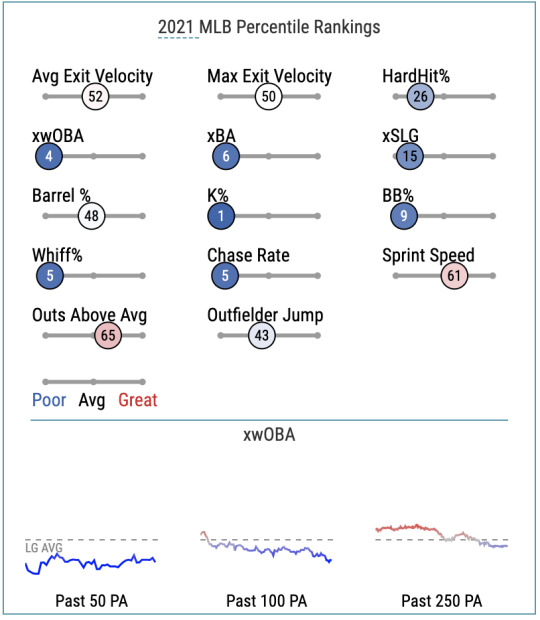
He did slash .268/.333/.515 last year in a 30-game sample, in case you want to convince yourself that he could be primed for some kind of a change-of-scenery surprise bounceback. Detroit is not going to ask for much in return, so if the Yankees are in desperate need of a warm body to play center field, he’s a trade option.
Yankees focus on: Lucas Luetge
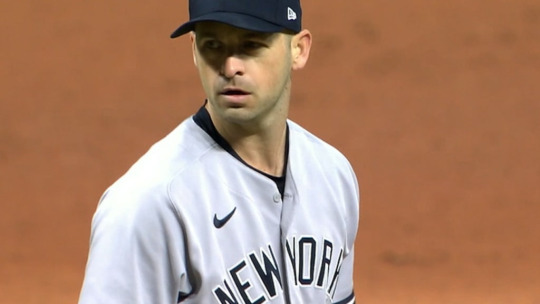
Luetge first made the majors with Seattle in 2012 and pitched for the Mariners for a few years as your run-of-the-mill lefty specialist, and not a particularly great one at that. He left them after the 2015 season and bounced around from organization to organization the next few years as a minor league depth piece, not once getting the call back up to the Show.
Now well into his thirties with a fastball that rarely reaches 90 and facing the reality of the newly-added three-batter minimum rule that largely made his archetype obsolete, it seemed like Luetge was not long for professional baseball. Instead he got a non-roster invite from the Yankees, pitched extremely well in spring training, made the major league roster, and is now doing this:
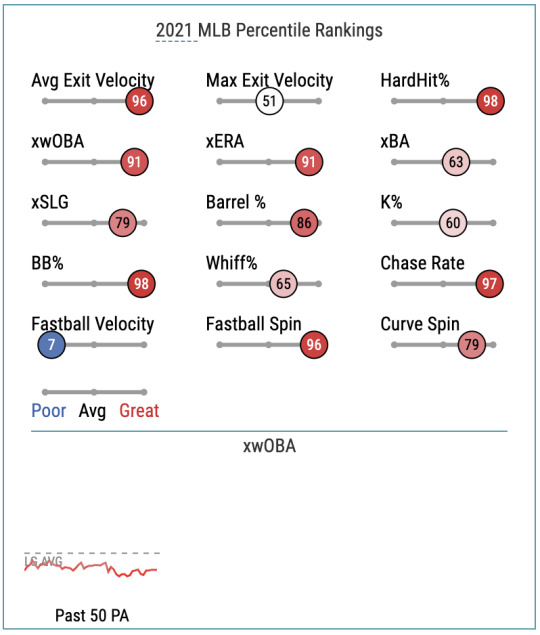
Not much was expected of him going into the season, but Luetge has posted a 2.66 ERA and 1.014 WHIP with a 24-to-3 strikeout-to-walk ratio in 23.2 IP. What’s more: after getting (predictably) crushed by them his whole career, Luetge has suddenly become really good at getting righties out! Right-handed batters are slashing just .211/.250/.316 against him in 60 PAs this year. How is it possible?
Basically he has been attacking them with his cutter, which is a pitch he only started to learn and throw in 2019. He has been working on it and building it up in the middle of his minor league forays the past few years, and it seems to have finally paid off this year. It is now by far his most-thrown pitch with roughly 64% usage, and he has located it really well and thrown it for strikes. It has paired brilliantly with his diving curveball, which has been close to unhittable so far this year as a put-away pitch.
It’s too early to tell if this is just small sample size noise or a legitimate career renaissance, but Luetge has rewarded the Yankees’ faith in him with some really solid innings in relief and has been one of their more inspirational stories in a bullpen that has a few of them. He managed to reinvent himself to save his career and the Yankees are reaping the rewards right now.
#Yankees#New York Yankees#Tigers#Detroit Tigers#Motor City Crying Kitties#JaCoby Jones#Casey Mize#Miggy#Yankees also have a Miggy#This should be a sweep#Lucas Luetge
0 notes
Text
Blue Jays (23-22) at Yankees (28-19)
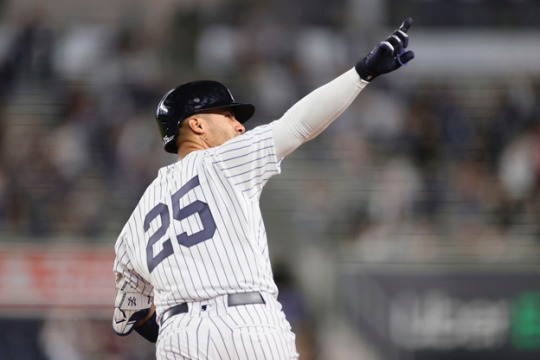
Tuesday – 7:05pm on YES: Steven Matz (5-2, 4.69 ERA) vs Corey Kluber (4-2, 2.86 ERA)
Wednesday – 7:05pm on YES: TBA vs Domingo German (4-2, 3.05 ERA)
Thursday – 7:05pm on YES and MLBN: Robbie Ray (2-1, 3.42 ERA) vs Jordan Montgomery (2-1, 4.07 ERA)
Blue Jays Injuries
RP Julian Merryweather: on 10 Day IL with strained oblique, no timetable to return
RP Tommy Milone: on 10 Day IL with shoulder inflammation, no timetable to return
OF George Springer: on 10 Day IL with strained quad, no timetable to return
RP Ryan Borucki: on 10 Day IL with strained forearm flexor, no timetable to return
UTL Cavan Biggio: on 10 Day IL with strained neck, no timetable to return
C Alejandro Kirk: on 60 Day IL with strained hip flexor, out for the season
RP David Phelps: on 60 Day IL with strained lat, no timetable for return
Blue Jays Pitching

Toronto has been reeling over the past week- they've lost five in a row (as of Sunday night) and between injuries and some players disappointing, they’re starting to be on the ropes. There’s the old adage of “you can’t win the division before Memorial Day, but you can lose it”, and with Toronto being 4.5 games out and in fourth place, they could definitely be in trouble. The Jays are in a tie for 11th in team ERA+ (109), but in a tie for 18th in FIP (4.33). They give up a lot of homers (1.4 homers a game) and are below average in WHIP (1.276 baserunners allowed an inning.) Toronto’s bullpen has been holding up despite losing Kirby Yates and Julian Merriweather, having a 3.49 ERA (fifth in MLB.)
Blue Jays Hitting

Toronto’s offense has been really, really good, despite losing Springer for most of the season so far, losing Kirk for the season, and Lourdes Gurriel Jr. and Rowdy Tellez being major disappointments. The Jays’ other major offseason acquisition, Marcus Semien, has been great, and really crushing fastballs and change ups- he’s hitting .340 with nine homers against fastballs and .379 with a homer and five doubles against change ups. He has been bad against breaking balls though: .120 with just one homer. He’s essentially back to the All Star level player he was in 2019, and a great addition to the Jays lineup.
Vladito is still killing it and living up to his promise:

He’s second in offensive bWAR (2.6), leading the AL in SLG, and is fourth in MLB in OPS. He’s absolutely crushing the ball and sending it across the entire field:
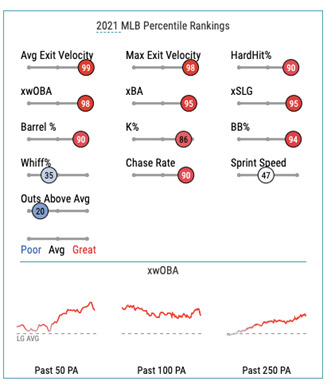

Vlad is leading MLB in Statcast’s Swing/Take leaderboard, which means that he is crushing pitches in the zone (17 runs above average on pitches in the zone) and not swinging at pitches out of the zone (8 runs above average in chase pitches.) It’s just honestly impressive how hard he is crushing pitches, the amount he swings and misses, but yet how rarely he strike outs and how often he’s still walking. Just a monster season for him as a 22 year old, and it’s something that we can all look forward to watching (or fearing, as long as he’s with the Jays.)
#Yankees#New York Yankees#Jays#Toronto Blue Jays#AL East#Baseball#MLB#Series Preview#Toronto you just chunked back to back games so don't stop now#please and thank you
0 notes
Text
White Sox (26-16) vs Yankees (24-19)

Friday – 7:05pm on WPIX: Carlos Rodon (5-1, 1.47 ERA) vs Jordan Montgomery (2-1, 4.75 ERA)
Saturday – 1:05pm on YES and MLBN: Dylan Cease (2-0, 2.41 ERA) vs Gerrit Cole (5-2, 2.03 ERA)
Sunday – 1:05pm on YES and MLBN: Dallas Keuchel (3-1, 4.44 ERA) vs Jameson Taillon (1-3, 5.73 ERA)
White Sox Injury Report
Jose Abreu: not on IL with knee surgery, and White Sox are “hopeful” he can give it a go this weekend
OF Eloy Jimenez: on 60 Day IL after getting pectoral surgery, expected back in late August
OF Luis Robert: on 10 Day IL with a torn hip flexor, hopeful to return this season
OF Adam Engel: on 10 Day IL with strained hamstring, no timetable for return
White Sox Pitching

Chicago’s pitching has been really good—second in baseball in ERA+ (127), and while as a team they aren’t the best in any single category, they’re consistently in the top 10 in pretty much every pitching statistic.
Starting the first game of the series is Carlos Rodon, who threw his first career no hitter earlier this season.

Rodon is having a career year this year—he was someone who always had a lot of talent, but struggled to stay healthy and be consistent. The White Sox actually non-tendered him in December, but ended up signing him for less than he would have gotten in arbitration later on as nobody else seemed to be really interested in him. The biggest change so far this season and the reason why he’s been so good?

His fastball has completely changed his career around—he didn’t have enough innings to qualify for 2020, but if he did, his 2.2 mph increase on his fastball would be the 8th biggest increase in all of baseball. All the other guys ahead of him are players bouncing back after a bad 2020 or relievers, as opposed to this being a new career high for him. His wOBA against his fastball is less than half what it was in 2019, and he’s getting nearly triple the whiff rate with it as well. His fastball had a +8 runs value in 2019, and now it’s -9, the sixth best pitch in all of baseball.
On the left there is his 2019 fastball location, on the right is his 2021 fastball location. It’s been a little higher in 2021 which helps, but the biggest difference is that in 2019 he was throwing about 91mph with low spin rate, and now he’s throwing 95mph.
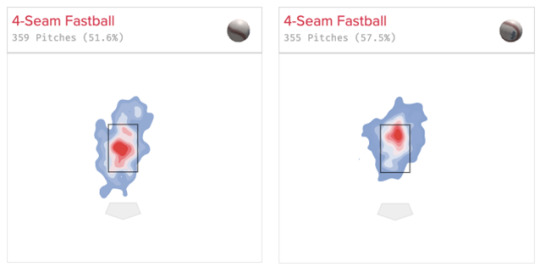
Rodon has always had a good slider, but now that he can play the slider off a really nice fastball it’s become a dangerous weapon—his slider is sitting about 85mph but with nearly double the horizontal break as the average slider. Interestingly enough, he’s willing to throw the slider against both righties and lefties, although he does throw it more against lefties. He also mixes in a changeup against righties, even if it’s not good (xBA is .278 and xSLG is .348.) The dominant fastball/slider combination has been lethal against lefties. Left handed hitters are slashing a disgusting .077/.111/.077 against him with just two singles and a walk allowed this season. Righties aren’t doing much better, but still better: .176/.276/.275.
The Game Two starter is Dylan Cease, who the White Sox acquired alongside Eloy Jimenez for Jose Quintana. A highly regarded prospect, he and Michael Kopech (acquired in the Chris Sale trade) were expected to be the future aces in the South Side, but until this year he hadn’t really put it together. Last year he had a 4.01 ERA, but a 6.96 xERA as he had an extremely low .238 BABIP against. This year? Some mechanical changes have helped to make his insane arsenal of pitches live up to their potential:

Cease is mixing a four seamer with elite spin rates and can reach triple digits with an absolute hammer curveball and a wipeout slider. There’s not a lot a hitter can do when you have the stuff that he does when he can mix it well and take advantage of it, and previously he just was not doing that:

That’s his 2020 pitch location. A lot of sliders in the zone, a lot of high fastballs away from righties, and his curveball was all over the place. Compare that to 2021:

Fastball is still in the zone, but when you have the velocity and spin that Cease has you can live with that. The bigger change is that the slider is now off the plate more, making it harder to get good contact on it, and the curveball is all low but accurate—playing the huge breaking ball off the high fastball is nearly impossible to hit, especially with a nearly 20mph difference between the two pitches. This graphic is a little messy, but I think it gets the point across:

All that red? Those are 97mph fastballs with a ton of spin. The yellow, green, and purple are sliders, change ups, and curveballs going way slower and also with a ton of movement. Easy to see why it’s hard to get hits off him.
Starting Game Three is Dallas Keuchel, who’s coming off a season where he finished fifth in Cy Young voting. Last season he had a 1.99 ERA and led baseball with a .3 HR/9 rate, but his xERA was 4.27 and as noted many times- he only faced hitters from the AL and NL Central, and outside of the White Sox there was exactly one other team with a 100 wrc+ or better which was Minnesota. Keuchel has been bad this year however, with a 4.44 ERA and an xERA of 5.80, and he has a couple really worrying signs—first percentile in K% (only striking out 11.6% of batters he faces) and is in the sixth percentile in xBA allowed. If you’re not striking guys out, you really cannot give up the kind of contact that Keuchel is letting (or the 7.6% walk rate).
That said, in his regular season career against the Yankees: 4-4 with a 2.22 ERA in eight starts, with two complete games, a shutout, and a 0.918 WHIP. That’s not even including his postseason starts, where in two of the three starts he went at least six shutout innings. So, while Keuchel has stunk this season, I’m still always going to be worried when he’s on the mound against us.
White Sox Hitting
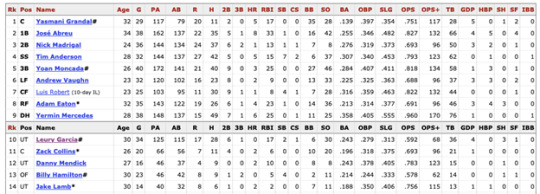
Despite all the drama going on with LaRussa and unwritten rules and everything, and despite losing Eloy and Robert for most of the season, this is still the best lineup in baseball right now with a 115 OPS+. They are third in BA (.260), second in OBP (.347), eighth in SLG (.412), fifth in doubles (70) and sixth in triples (9). They’re also fifth in extra bases taken %, and tied for first in the percentage a runner on base scores (36% of the time.) If you like watching offenses that don’t rely on the homer, this is your team- the White Sox have only 41 homers (23rd in baseball) but are consistently putting the ball in play.
Having Yermin Mercedes, Yoan Moncada, Tim Anderson, and Nick Madrigal really help in that regards. Madrigal and Moncada don’t really have a lot of power, but both put the ball in play consistently. Mercedes has come out of nowhere to lead the majors in batting average as is putting up an All Star season as well.
Tim Anderson has been one of the most fun players in baseball to watch over the past few seasons, and he’s been the big competitor to DJ LeMahieu winning batting titles—he led the majors in 2019 with a .355 batting average, and was second in the AL last year with a .322 average. A big part of that success is his batted ball types:

He’s able to spread the ball out across the field (with a ton of balls directly up the middle, isn’t popping the ball up (which is a near guaranteed out) and his grounders have been finding holes. He’s also been elite against fastballs over the past few years, his lowest batting average against fastballs in a season has been .352.
The big issue for the White Sox is their outfield — just not getting any hitting by anyone with Eloy and Robert out.
Yankees Focus on: Corey Kluber
Kluber just pitched the first no-hitter this century for the Yankees, and deserves a bit of a a breakdown for how successful he’s been his last few starts:
Not exactly a murder’s row of offenses, but outside of one inning against Baltimore he’s been really, really good!

Kluber so far has had reverse splits:

Which is almost entirely based on how disgusting his cutter and changeup have been this year. His change up, which he’s throwing nearly twice as much as he did when he was a Cy Young candidate, has a .125 BA against (all singles) and a near 50% whiff rate. He’s using it to put away batters 37.5% of the time, and the 80mph exit velo against it is elite. His cutter has always been his best fastball, and while it’s not the fastest pitch or and doesn’t have a ton of spin on it, he is locating it really well against lefties:
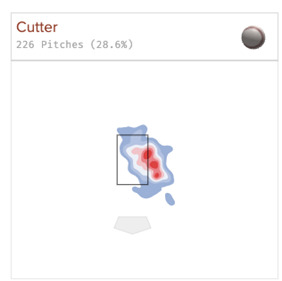
Against righties, he hasn’t had much success, mostly because his sinker still is struggling—.304 BA against, .543 SLG against, and it’s allowed five of his ten extra base hits. This has been a consistent problem for Kluber however- his sinker was worth +7 runs in 2017, +9 runs in 2018, and +7 runs in 2019 as well. Part of that is his sinker location:

That’s a lot of sinkers up and over the plate, which are usually pretty hittable. His saving grace against righties though is his breaking ball, which is still an elite pitch: .189 BA against and .264 SLG against, with a 38.5% whiff rate. When you look at how he’s located the cutter, the change up, and the breaking ball, and compare it to a zone chart for his wOBA allowed, it makes perfect sense:
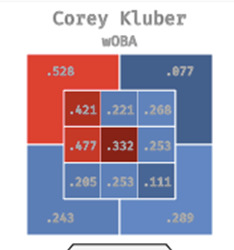
Anything away from righties (his cutter and breaking ball) or inside or low and away vs lefties (cutter and changeup) has been perfect. Anything up and in on righties is getting smoked, which happens when you don’t have elite speed or spin rate on your heater.
Another impressive thing is his willingness to use different pitches in different counts:

To me that says he’s feeling comfortable and back to being the Kluber of old, he’s obviously using the breaking ball and changeup more often in two strike counts, but he’s still using them when he’s behind in the count as well. You can’t just sit there and say “awesome, he’s gotta throw a fastball here” or “I’m just going to lay off the low and away breaking ball” because he’s using everything in his arsenal at all times.
After getting moved over to having Higgy as his personal catcher, he’s been dynamite as well. As always, it’s hard to know if it’s specifically Higgy doing anything or if he would have done the same with Gary, but he’s been cruising with Higgy:

Finally, maybe the best news for Kluber being back are these stats:

That’s Kluber’s stats per pitch in the game. The next graphic is Jameson Taillon’s stats per pitch:

Taillon has been starting hot, but getting worn down and lit up later in his starts. Kluber has been consistent and isn’t getting tired.
Kluber when he faces opponents for the first, second, third time:

As opposed to Jamo:

And lastly, Kluber on normal rest vs extra rest:

vs Jamo:

All of those are saying to me that Kluber is back to normal—he’s not getting tired, he’s able to use all his pitches throughout the game and mix things up, and he doesn’t need the extra time between starts. At this point, I think Kluber is officially back to being an elite pitcher, now it just comes down to whether or not he can last through October.
#Yankees#New York Yankees#White Sox#ChiSox#Chicago White Sox#Carlos Rodon#Corey Kluber#Jameson Taillon#Tim Anderson#Tony La Russa is an idiot#And a drunk#YerminWasRight#Did I mention that TLR is a drunk idiot?
1 note
·
View note
Text
Stats Club 101 - Counting and Basic Rates
Evan’s Note: Hey, look at this! Another new contributor. We’re growing faster than Ortiz’s ass after the steroid needle hits it. Anyway, everyone say hi to AJ and yeah, go ahead and make another one more when you bring cupcakes to class next week.
———
While Evan, Sam, and now Julio are breaking down players and series previews, I’ll be focusing on the NUMBERS! and SCIENCE! that surround baseball. Before you even think about yawning, let’s be clear: you’re a baseball fan. You do like those things in this context; you just don’t realize it. Hopefully I can help demystify the decimals and acronyms and spinning and launching, making it a little less scary and giving you a new perspective with which to think and talk about our beloved sport.
First up: The first installment of a dive into baseball statistics.
———
It’s no surprise: baseball is numbers-heavy. Likely because it can be mostly described by discrete and well-defined events, baseball lends itself to digits upon digits upon digits. The spectrum of fan acceptance of this spans from those developing modern sabermetrics, to those who blame the Inevitable and Imminent Downfall of the Sport (100+ years and counting!) on anything outside of “traditional” stats. In-between you have everyone else: fans who don’t care either way; those who care a little either way; those who want to understand but find it all so damn intimidating; and even those who think they get it but carry major misconceptions (looking at you, r/baseball and your abuse of ‘regression’).
Well regardless of where you sit, Welcome to Stats Club! We’re gonna take a close look at the classes of baseball metrics, where they come from, and how to interpret them. Before we kick things off you should know of a few key rules:
The first rule of Stats Club is: Stats are not bad.
The second rule of Stats Club is: Stats are not bad!!
But seriously, statistics are tools. Saying a specific stat is fundamentally bad because it doesn’t tell you something it wasn’t designed for is like saying a screwdriver sucks because it can’t hammer nails. The formula is what it is: what’s potentially bad are the inferences you draw from it.

For example, suppose I make a measurement that is the total number of apples and oranges in my fruit basket: I call it 'wAO’. It’s very specific, sure, but it’s still carrying information. And although it only counts those two fruits directly, you may be able to infer what’s happening with the rest of my fruit supply if you know how much my basket can hold; e.g. a low wAO may mean I have bananas and kiwis too. But if you’re wrong, that’s not the fault of wAO. Rather, your methodology is flawed by not accounting for your own assumptions. Keep this in mind as we step through baseball statistics, especially when we get into sabermetrics.
A third thing to be aware of is: unless stated otherwise, baseball stats are not predictive. They are records of the past, and we assume things will stay mostly the same going forward. But this is an assumption, and depending on what we’re talking about it can be a pretty bold one.
Part I. The Counting Stats
<Hits, home runs, RBIs, strikeouts, innings pitched, etc…>
Ah, it’s the most basic category: the stuff you can literally count. Counting stats get scoffed at because of how simple they are, but they’re at the core of everything that follows. After all, you can’t build a model of player production without having raw data to throw into your equations.
As I mentioned earlier, baseball is a nice sport from a statistics perspective because it can be almost completely described by counting stats, which are descriptions of discrete events. A batter does or doesn’t reach base; a pitcher either gets a strikeout on 3-2 or he does not; and so on. Compare to, say, soccer, where it’s not so easy to cleanly describe and quantify the details of player performance.
I say almost completely described because fielding remains a challenge. Errors are an attempt, but errors are a divisive counting stat because they’re uncharacteristically subjective for baseball. Like with soccer where we’re trying to measure continuous and complicated events, advanced analytics are really the only way to quantify fielding in any detail. But we’ll save that discussion for a later post.
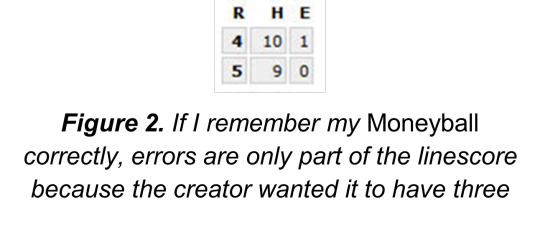
Part II. The Rate Stats
<Batting average (BA), On-base percentage (OBP), Slugging percentage (SLG), etc…>
Counting’s great, but raw numbers can get large and unwieldy and difficult to interpret. We solve this by normalizing them, i.e. dividing the count by some standard unit. Then we get a rate, or measure of how often something has occurred (remember: baseball stats are not inherently predictive). BA is the rate of hits per official at-bats; OBP is the rate of reaching base—hits and walks and hit-by-pitch—per plate appearance; and so on.
For pitchers, Earned Run Average (ERA) is earned runs per inning pitched times nine, which just scales the rate to an entire 9-inning game. There’s also Walks and Hits per Inning Pitched (WHIP) which says what it is right in the name. On baseball-reference you’ll find SO9 and HR9, which are strikeouts and homeruns per inning, respectively, also times nine for the same scaling as ERA (for whatever reason pitchers get their rates expressed as whole numbers while hitters are stuck with fractions).
Let’s illustrate the first two rules of Stats Club by looking at the much maligned BA. It’s perfectly reasonable to measure how often a batter reaches base via a hit. Hits are exciting! There’s a crack of the bat, the ball goes into play, and the fielders scamper to unsuccessfully throw the ball in before the batter-turned-runner can reach. Not to mention, making contact with a small 90mph projectile and placing it where it can’t be fielded may be the hardest thing to do in all of sports, so getting a hit is always an impressive feat.

But none of this is to say hits are the only things that matter. If you’re trying to get on base you don’t really care how you do it, and from that perspective a walk is just as beneficial as a single (even if Nick Johnson’s knowledge of the strike zone is slightly less dramatic than a clutch Gio Urshela double down the line). Thus the problem is not in BA being what it is, but rather in old-school baseball minds deciding it is the be-all, end-all of offensive measures. So definitely celebrate high batting averages, but don’t use it to definitively say one player is better than another. There are more appropriate tools for that.
Part IIa. OPS and Other Fun Rates
On-base Plus Slugging (OPS) is technically a rate, but it’s unique because it rather unceremoniously—but somehow very comfortably—smashes two other rates together: OBP, and the intimidatingly named SLUGGING PERCENTAGE (SLG), which is bases per at-bat.
The idea behind adding the two is straightforward. In baseball you want to generate runs. And you do this by either getting on base or by hitting the ball so you get a lot of bases. Hey, that’s OBP and SLG! So if we add the two together we get a number that kinda captures a player’s rate of run creation. Hence, OPS.
There was a time when I ignored the first two rules of Stats Club and hated this number. Since the same hit is captured in both OBP and SLG, isn’t it double counting? And wait a second, OBP and SLG have different denominators; you can’t just add them! But as I went through my career I realized I was overthinking it: OPS is fine. Between 9am and 5pm on weekdays I’d call OPS a basic heuristic. A heuristic is a broad concept: it refers to any good-effort way to get a solution or estimate to a problem. Heuristics are explicitly not meant to be optimal or perfect: they just need to be justified by the designer. And OPS can be justified! Aside from the conceptual idea of run creation, it can be shown that OPS tracks with—and even has some level of prediction for!—actual runs scored. So there you go.
But be aware that even given that, we’re still inferring things about run creation from OPS. Inferences still rely on assumptions and interpretations and there was a desire to get more precise. Stats guys wanted a more refined tool to directly measure production. One of these tools is called weighted on base average (wOBA), but we’ll discuss that later when we dive into advanced metrics.
Batting Average on Balls in Play (BABIP) is another fun one. BABIP also has its description in its name: it’s like BA, but instead of hits per at-bats, it’s hits per balls-in-play (i.e. it ignores strikeouts and HRs). BABIP is used to gauge the statistical un/likehood of a hitter’s performance. The logic is as follows:
Major league ballplayers have a baseline level of fielding skill. That is, there are zones in which any competent player should be able to field a ball and record an out. That means there are also zones where that fielder won’t be able to make a play, and thus the batter—if he places it there—will get a hit.
Given all that, we can expect a ball in play to be a hit about 30% of the time. If a hitter’s BABIP is far below .300, the implication is that fielders are making spectacular plays. And since spectacular plays are spectacular for a reason, the hitter is probably getting “unlucky”. Or perhaps he’s hitting into crazy shifts. Either way, a good hitter will adjust his approach and/or benefit from defenses being less spectacular. As a result, the expectation is that in due time he will see his BABIP regress upward towards .300. And if his BABIP goes up, so will his BA.
On the other hand, if a BABIP is far above .300, it implies the hitter is getting lots of bloop hits, which he certainly isn’t planning. Or maybe he’s beating defensive alignments, which any competent defense will recognize and adjust to. Whatever the reason, we’d expect his BABIP to regress down towards .300, accompanied by a drop in BA.
(BIG NOTE: Player skill is a factor here too! Elite hitters will be better at finding those gaps and can maintain a BABIP of around .350, while the worst hitters may sit as low as .260. If we know a player’s true BABIP after seasons of playing, we can have a good guess of how his BA may trend based on BABIP.)

For a while BABIP was THE indicator of statistical un/likelihood (or un/luckiness). This is why we curse the BABIP gods when one of our guys is “robbed” or when a team--probably the Rays or mid-aught Angels--bloops us to death. But thanks to Statcast, BABIP has been given a partner. Because Statcast logs everything about batted balls, we can, in real time, know exactly how often that type of contact (launch angle, exit velocity, etc.) has resulted in a hit vs. an out. No more inferences required! You know this stat as expected batting average (xBA). But more on that later.
Remember: Stats Are Not Bad. This is some cool synergy between classic rates and new-age Statcast. Use xBA for real-time analysis, but turn to BABIP when trying to project long-term trends.
Part IIb. Time to Normalize…Again!
Rate stats exist to make counting stats more readable, but it’s still not obvious what rate is a good rate. This is something you had to learn when you first got into baseball: you weren’t born with the knowledge that a .330 BA may win the batting title, or that a 5.36 ERA for a starter is disappointing. Rate stats are a useful tool but they don’t tell if a rate is what you want.
Enter the “pluses”, mainly OPS+ for hitters and ERA+ for pitchers. These are essentially the raw rates normalized by the league average rate, times 100 (so it’s not a fraction) with a few other adjustments. This gives a direct comparison to everyone else in the league over that period of time. If a pitcher has an ERA+ of 101 it means he’s in the middle of the pack, whereas an ERA+ of 205 means he’s 100% better than the league average pitcher. Similarly, an OPS+ of 90 says a hitter’s inferred run production is 10% worse than the rest of the league. The pluses are my favorite to look at because they’re nice clean numbers that quickly provide a lot of information.
Baseball-reference iterates on this with tOPS+ for player splits. This is the player’s OPS for that split, e.g. the month of April, normalized by his OPS for the entire year. This lets you quickly check out fluctuations over months, counts, and other situations.
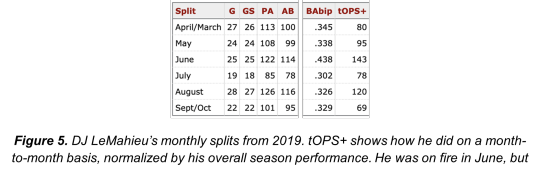
Ok, two caveats here. First, the pluses are also adjusted by a “park factor”, which is a number that describes how pitcher- or hitter-friendly a stadium is. If two pitchers have the same ERA but one plays in an extreme hitters park, he will have a higher (i.e. better) ERA+ because the park factor adjustment accounts for how he has to work harder.
Secondly, because of how OPS+ is calculated—it actually sums what you could call OBP+ and SLG+—an OPS of 90 doesn’t exactly mean 10% worse than league average OPS. That’s why, in the example above, I said 10% worse run production instead. And now we’re bordering on more abstract concepts that may require additional tools to describe...
———
--And that is a good place to end today’s lesson. To recap: we started with counting to collect raw baseball data, and then we normalized those counts to get rates. To easily compare those rates we normalized again, but with a twist: to be a fair comparison we needed to adjust for the quirkiness of the various ballparks. And that’s not exactly something you can just count. You need a model, and more specifically, a model that checks out.
Furthermore, what about our sharper version of OPS? How do we more accurately and directly measure run production? And since errors are a weirdly subjective stat, and because hits themselves depend somewhat on defense, is there a way to meaningfully evaluate a pitcher’s performance while somehow ignoring hits and runs?
The search for answers to these questions gave rise to the advanced metrics, or “Sabermetics”. wOBA, FIP, WAR and others are newer heuristics that use the history of baseball stats to develop models of performance. Next time we’ll dissect a few of these to better understand what exactly they’re telling us.
— Extra Credit —
< A place for footnotes and other remarks for the nerdiest nerds >
Throughout all this I’m going to use the statistics meaning of regression, which means a trend. The concept of regression towards the mean refers to trending towards a true average. It does NOT mean “To arbitrarily get worse”! Baseball fans routinely mess this up and it leads to very bad analysis! Much more on that later.
Isolated Power (ISO) is a rate like SLG, but it only counts doubles, triples, and HRs and gives them weights of one, two, and three, respectively (It can also be calculated as SLG minus BA). As you can guess from its name and its components, it’s a heuristic used to capture power hitting.
Here’s a fun quirk. A player’s OBP is always higher than his BA, right? Not necessarily! Check it out:
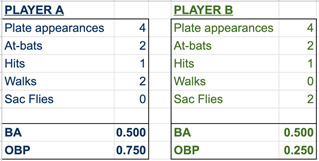
Two players with identical BAs for this game but very different OBPs. What’s happening here? It’s the sac flies! Since SFs count as a plate appearance but obviously not as getting on base, they go into the denominator of OBP but not the numerator. So if a player has more SFs than BBs, it won’t affect his BA but it will bring down his OBP. Of course, no actual major league player should have more sac flies than walks over any meaningful period of time, so this is mostly an early season quirk.
0 notes
Text
Yankees (22-18) at Rangers (18-24)
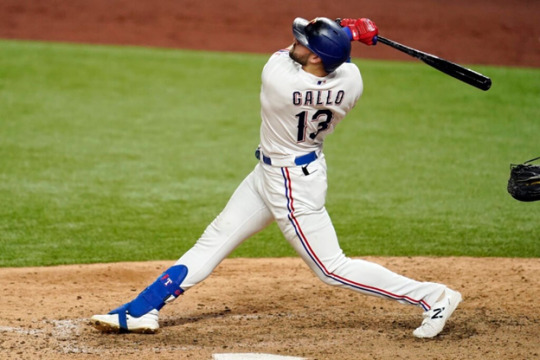
Monday – 8:05pm on YES: Gerrit Cole (5-1, 1.37 ERA) vs Jordan Lyles (1-3, 6.63 ERA)
Tuesday – 8:05pm on YES and ESPN: Jameson Taillon (1-3, 5.40 ERA) vs Mike Foltynewicz (1-3, 4.60 ERA)
Wednesday – 8:05pm on YES: Corey Kluber (3-2, 3.48 ERA) vsTBD
Thursday – 2:05pm on YES and MLBN: Domingo German (3-2, 3.62 ERA) vs Dane Dunning (2-3, 3.42 ERA)
A Brief Section on Globe Life Field
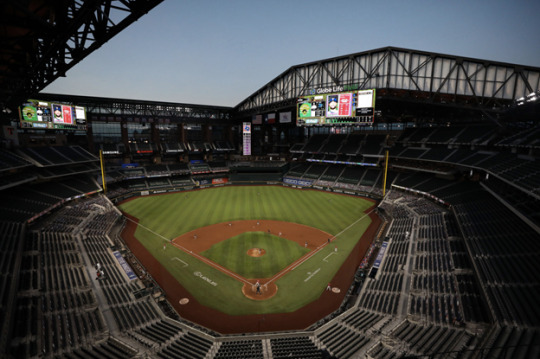
This is the first time the Yankees will be playing at the new Rangers stadium, and it plays pretty differently than the previous park.
Now obviously Globe Life Field held the NL postseason and the World Series last year, but this is the first season where the Rangers have gotten to play in front of fans there. GLF’s dimensions are all honoring important Rangers players and moments:
Left Field Pole is 329 feet in honor of Adrian Beltre
Left Field inside the line is 334 feet in honor of Nolan Ryan
Left Field power alley is 372 feet as the Rangers first played in Texas in 1972
Deepest dimension is 410 feet in honor of Michael Young
Straightaway centerfield is 407 feet in honor of Pudge Rodriguez
Right Field power alley is 374 feet in honor of the 1974 Rangers having the first winning season ever
Right Field Pole is 326 feet in honor of Johnny Oates
42 feet from the plate to the backstop in honor of Jackie Robinson
Compared to the previous Rangers ballpark, the new Globe Life Field is a pitcher’s paradise: at the old Ballpark in Arlington, there were 19% more runs than average, 12% more home runs than average, and wOBA was 9% higher as well. It consistently ranked as one of the best hitter’s parks outside of Coors. In comparison, the new stadium is really tough for hitters: it was 11% worse than average in homers allowed last year (although its back to league average so far this year), 4% worse than average in runs allowed, and 2% worse than average in wOBA.
Rangers Injury Report
UTL Brock Holt: on the 10 Day IL with a strained hamstring, no timetable to return
SP Kohei Arihara: on the 10 Day IL with a finger contusion, no timetable to return
Rangers Pitching

The Rangers rotation is kinda like the Island of Misfit Toys—it’s been high profile guys who have gotten dumped after poor performances or guys that have been passed around, but the Rangers are trying to take fliers on guys with some track record of success and then trade them for prospects. The big issue with that for Texas is when they have guys that DO actually perform well, they hold onto them for far too long and get limited returns instead (see: Lance Lynn and Mike Minor.) Rangers pitching as a whole has a 93 ERA+, which is really quite bad. While they are in the top 10 in walks allowed (3.02) they have allowed the most hits in baseball (362) and second most homers (54) and are below average in strikeouts. The bullpen is 17th in baseball with a 3.94 ERA as well, although the bullpen does have a couple nice bright spots in it.
Starting game one is right handed pitcher Jordan Lyles. Lyles is a four pitch pitcher—he’ll use his four seamer and curveball against righties and lefties, and mixes in a slider for righties and a change for lefties. His fastball, to be completely fair and honest, is garbage—it’s a 93mph fastball with okay movement, but it’s -9 run value makes it the second worst pitch in baseball this season (last year it was only the fourth worst pitch in all of baseball, so maybe there’s room for improvement?) He throws the fastball nearly 50% of the time, and opposing hitters are slugging .705 against it, which is just awful. It has a 64.7% hard hit rate. He’s allowed nearly as many extra base hits (10) as strikeouts (11) with it.

That’s Lyles’ pitch percentages by zone for a fastball—notice 8.4% of those are meatballs and then another 25% of those are up and in against righties/up and away against lefties.
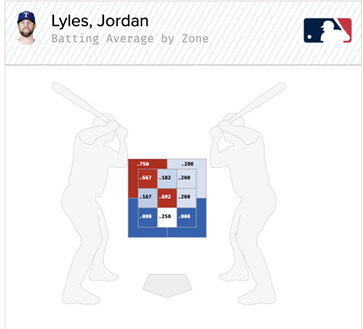
Yeah, allowing over .600 batting averages on a third of your fastballs is a good way to end your Major League career.
Game two starter is Mike Foltynewicz, who in 2018 was an All Star for the Braves and got Cy Young votes for them as a 26 year old. Unfortunately for Folty, 2019 was a bad year and 2020 was a disaster- he lost 5mph off his fastball, lost a lot of weight, and was promptly DFA’d during the season. 2021 has been a bit better so far for him- his fastball is back up to 94mph, still slower than it was in his prime, but better than the high 80’s fastball he was rocking last year. His slider looks to be back in rhythm as well—opponents are hitting just .196 off his slider this year and he has 22 strikeouts in 46 at bats finishing guys off with it. Where Folty’s problems come from however are his awful platoon splits: righties are slashing .257/.292/.475 with five homers and 26 strikeouts in 101 at bats. Lefties are slashing .315/.386/.658 with six homers and 13 strikeouts in 73 at bats. His change up and curveball, both lefty only options, are getting destroyed.
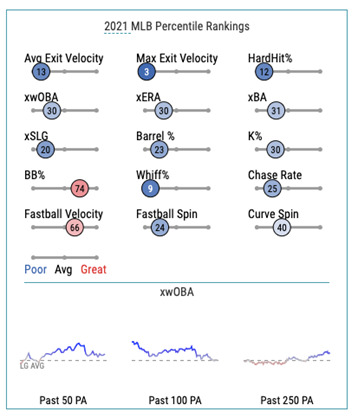
Folty has always been a stuff guy and more of a thrower than a pitcher, but when your stuff isn’t blowing guys away, you’re not really that valuable on the mound.
Lastly I wanted to give a shoutout to former Yankee prospect Ian Kennedy for putting up his best season in a decade as the Rangers closing pitcher. Kennedy was originally traded to the Diamondbacks as part of the Curtis Granderson trade in 2009, but he’s still alive and kicking out of the pen in Texas now. Ian’s basically gone from throwing four pitches as a starter to throwing his 4 seamer 80% of the time, which is probably a great decision: it’s only 94mph, but it has elite movement—an extra 2.1 inches of drop and an extra 2.6 inches of horizontal movement.
He’s just going to pound the strike zone with heaters and hope that you don’t rip him apart, but so far this season it’s been working really well.

Rangers Hitters

Texas’ lineup is starting to get back on track a bit after a brutal 2020 season. As a team they have a 100 wrc+, which is 10th in baseball, and are 8th in homers hit. They do have, in typical Rangers fashion, the fifth most strikeouts, but also in typical Rangers fashion they’re aggressive on the base paths—third in stolen bases (28) and 11th in extra base taken % (42%.)
While former Yankee prospect Nick Solak is doing really well, and the star of the team is the always fun Joey Gallo, the breakout star of the Rangers so far has been Adolis Garcia:
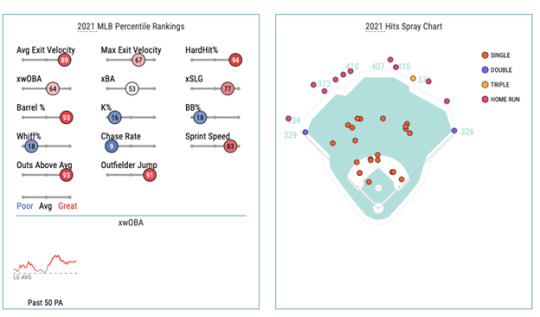
Garcia has come from virtually nowhere to play an elite outfield and has just been crushing balls all over the park, but he does have an unsustainable .352 BABIP and 16% barrel rate. Is he going to stay good? My guess is yes, but I don’t think he’ll be a near MVP candidate the rest of the season.
#Yankees#New York Yankees#Rangers#Texas Rangers#MLB#Baseball#Series Preview#Breakdown#Jerry Gallo is dead--I know that!
0 notes
Text
Yankees (18-16) at Rays (19-17)
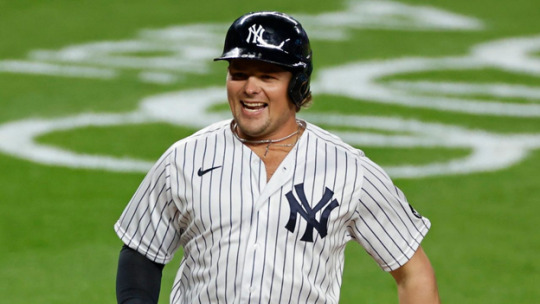
Tuesday – 7:10pm on YES and ESPN: Jordan Montgomery (1-1, 4.41 ERA) vs Luis Patino (1-0, 1.17 ERA)
Wednesday – 7:10 on YES: Gerrit Cole (4-1, 1.61 ERA) vs TBA, most likely Yarbrough for the bulk innings (2-3, 4.58 ERA)
Thursday – 7:10 on YES and MLBN: Jameson Taillon (1-2, 5.02 ERA) vs TBA, most likely Rich Hill (1-1, 5.17 ERA)
Rays Injury Report (since we last played them)
RP Pete Fairbanks – activated off IL on May 5th
RP Collin McHugh – activated off IL on May 5th
1b Ji-Man Choi – finishing rehabbing injured knee, expected to be activated for series vs Yankees
RP Chris Mazza – placed on 10 Day IL due to shoulder inflammation, no timetable for return
SP Michael Wacha – placed on 10 Day IL due to hamstring strain, no timetable for return
RP Diego Castillo – placed on 10 Day IL due to strained groin, no timetable for return
C Francisco Meijia – placed on 10 Day IL due to strained oblique, no timetable for return
OF Kevin Kiermaier – placed on 10 Day IL due to sprained wrist, no timetable for return
Rays Pitching
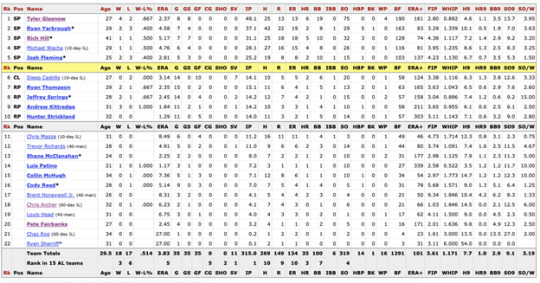
The good news for this series is that the Yankees avoid Glasnow, who’s still pitching at an All Star level. The bad news? The Rays, despite having seven relievers on the IL right now along with three starting pitchers, are still able to put out multiple elite relievers. Obviously guys like Fairbanks, Strickland, Thompson, and Kittredge have put up nice seasons in the past, but they’ve also started to use some of their top end prospects like Shane McClanahan out of the pen too with a ton of success.
McClanahan, a consensus Top 100 prospect in baseball, is a lefty who made his first career MLB appearance vs the Yankees in the ALDS last season, and mixes a sweeping slider with 33 inches of drop and 4.4 inches of horizontal break (both significantly above average) with a 99mph four seamer with 52% more horizontal break than average.
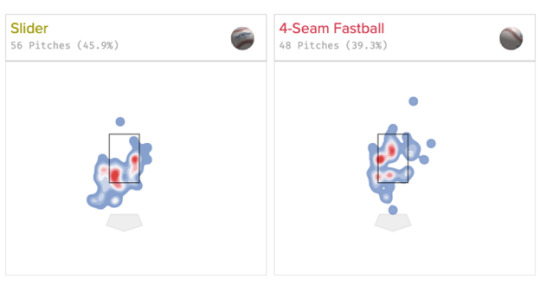
The slider is legit—in 12 at bats ending with the pitch, opposing batters have struck out eight times and only gotten one hit. The fastball however is a different story—despite having a lot of life to it, he’s leaving it smack dab in the middle of the zone and people are teeing off on it to a tune of a .506 xSLG.
The other main new piece the Rays have been trotting out is Tuesday’s starting pitcher Luis Patino. He was MLB Pipeline’s #23 prospect in 2020 when he was with the San Diego Padres organization, and was one of the main pieces of the Blake Snell deal this past winter. His star started to shine a bit less after a messy 2020 season in San Diego, as he had a real trouble with throwing strikes (16.5% walk rate was in the second percentile) and was miserable when even or behind in the count (opposing batters had a .845 OPS when ahead in the count, a 1.118 OPS when even in the count, and just a .495 OPS when behind.)
I saw him pitch when he was with Single-A Fort Wayne, and you could tell then that he had the potential to be truly special. He was just 18 years old, nearly four years younger than the average Midwest League player, but his stuff is just electric- he has a fastball that sits in the mid 90’s and lasts throughout the whole game, but can touch 100mph. It doesn’t have a ton of movement to it, but it does have a ton of spin (89th percentile in fastball spin rate in 2020, to go along with 94th percentile in fastball velocity.) The go to out pitch however is a disgusting slider- only 27.1 inches of drop (20% less than average) but it gets nearly double the average horizontal break on it. The slider has a 45.5% whiff rate this season and has gotten 8 strikeouts in 14 at bats. More importantly, he’s started throwing strikes more:
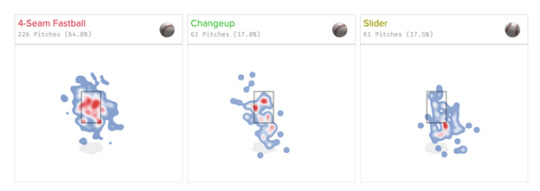
Those are his 2020 pitch charts, where he was really all over the place and had to use his change up more often (more on that in a second).
Compared to his 2021 pitch chart, where everything is a lot tighter and he’s thrown the slider for strikes.

He also has a change up, which is 88mph with a low spin rate and low movement, and he uses that almost exclusively against lefties—it’s really the pitch he needs to improve upon if he wants to live up to his billing as a top end starting pitcher, but despite not really having the underlying numbers to back it up, it has been successful so far in his MLB career. In his limited MLB career so far, he actually has reverse splits (righties are slashing .259/.368/.414 and lefties .158/.273/.536), but in his last MILB season righties slashed .163/.259/.220 compared to lefties slashing .262/.308/.443. I’d be willing to bet that his reverse splits right now are nearly purely small sample sizes and that things will go back to normal quickly.
Rays Hitting

Tampa has been improving their offensive numbers, and are up to a 99 OPS+ as a team so far this season (tied for 13th in baseball.) Getting Choi back helps, as it can for Tsutsugo out of the lineup more often as his 38 OPS+ is dragging down the Rays offense drastically—Tampa has the 5th worst OPS out of the DH position. Ideally, they’d be able to play Meadows there more often, but Kiermaier’s injury takes away his Gold Glove level defense and forces Tampa to play Meadows’ Garbage Glove level defense in LF.
Tampa has been getting good production from the majority of their team however—Zunino has doubled his OPS+ from last year so far and Diaz, Wendle, Meadows, and Arozarena are right where you’d expect them to be in the heart of the order. Adames has been the weak link so far of the every day guys, which is not a place you want to be in when Wander Franco, the consensus top prospect in baseball, is currently crushing the ball in AAA.
Yankees Focus On: Starting Pitchers
Because we’ve faced Tampa twice in the last month already, I figured it’d be a little better to spend more time breaking down our own starters for this series.
First up—Jordan Montgomery: if you want to look at some upside with Gumby, you can point to the fact that he has really battled back from some lousy starts and moments that he just didn’t have it this season. If you want some downside with Gumby, there’s been a lot of those moments. Gumby has a 6.00 ERA in the first inning this season, batters are slashing a very high .364/.417/.871 when leading off an inning, and against non-Orioles teams he’s been a mess:

He’s had miserable platoon splits—lefties are slashing .138/.219/.138 with 10 Ks and 1 BB in 32 PA, but righties are slashing .272/.323/.489 with 18 Ks and 7 BBs in 100 PA. His home/road splits are similar:

Now it’s easy to say “oh it’s been a month, give it some time” with Gumby, and with some of the other pitchers on the team I’d agree, but unfortunately all his career numbers are similar—significantly a different pitcher at home, vs lousy teams, and against lefties than he is on the road, vs winning teams, or against righties. One of the biggest issues he’s running into is that he just really struggles against the best of the best:

It’s hard to trust Gumby when he’s on the mound because of all this—he’s reached 90 pitches in a game just twice in the last two seasons and pitched into the 7th just once (he was pulled after letting the leadoff hitter on in the 7th inning this season against Tampa).
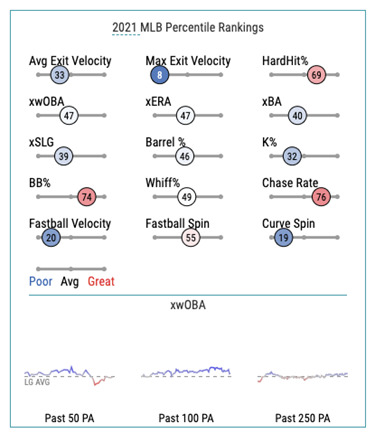
His underlying numbers aren’t that great either—he’s still not walking guys (just a 6.1% BB rate) but he doesn’t get strikeouts and allows a lot of hard contact. Last year he was in the 95th percentile in average exit velocity, this year he’s in the 33rd percentile, mainly because his sinker and his cutter suck.
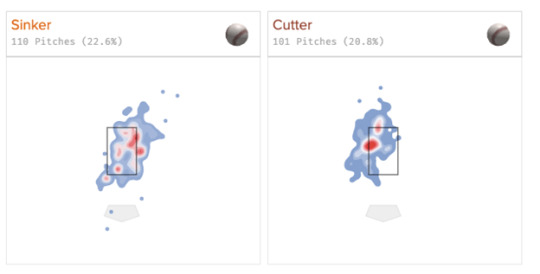
Those are two pitches with not a lot of movement to them and not a lot of speed to them that are being left in very hittable places for hitters—here’s a zone chart for SLG and xSLG for righties against Gumby:

Not great! He’s leaving those cutters and sinkers all over up in the zone and guys are destroying those pitches.
That being said, the curveball has been elite offerings from him this season: curveball has a .071 SLG and .192 xSLG and is actually his most used pitch at 23.7% of the time (although he does throw a variation of his fastball over 50% of the time.) His change up has gotten good results- right now it has a decent .314 wOBA (although it does have a much higher .440 xWOBA, and if it starts to perform like that then he’s really in trouble.)
At this point I’m not writing Gumby off, he did have a really nice 2017 after all, but he’s now three years removed from Tommy John surgery and the results just have not been there.
In much more positive news, Gerrit Cole is really freaking good at baseball.

Those are his numbers in his Yankee career, and he’s been really worth every penny of the contract so far.
Maybe the most insane thing that Cole’s done this year is put up a 40.2 K% and a 1.8 BB%: the only two SP with a higher difference are Jacob deGrom and Corbin Burnes, who both have roughly a 45% difference between their K rate and BB rate. He’s also drastically cut his HR/FB% down, last year 18.7% of his fly balls left the yard, this year it’s down to 7%. He gave up 14 homers in 73 innings last season, this year he’s given up three in 44.2 innings.
Obviously the big change Cole made this season, as YES mentions every time he steps out on the mound, is that he has embraced the Matt Blake Change Up Factory approach, and to good measure. Last season he threw a change up 5.6% of the time, almost entirely against lefties and to the tune of a .268 wOBA. This year that number is up to 15.1% of the time, it’s used against righties and lefties, and it has a .041 wOBA thanks to one hit against it in 31 PA. His change up is the third best change up in baseball in run value so far this year, only behind John Means and Ian Anderson. He also has the 17th best four seam fastball in run value, and those two pitches play off each other perfectly:
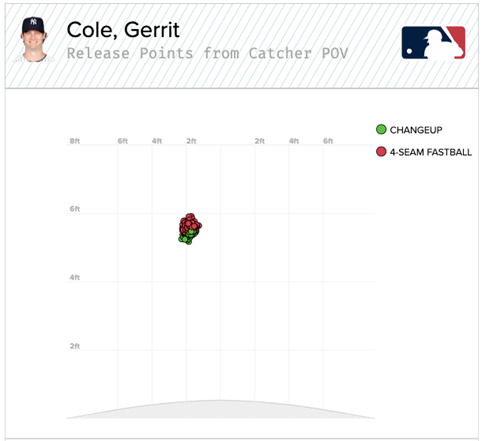
That is excellent tunneling for two pitches with similar movement but a 10mph difference to them—Cole’s change up actually drops significantly less than the average change up and has similar horizontal movement to his four seamer, so it’s really hard to tell the difference in the two pitches. Here’s a pitch chart from his start against Detroit, with four seamers in red and change ups in green:
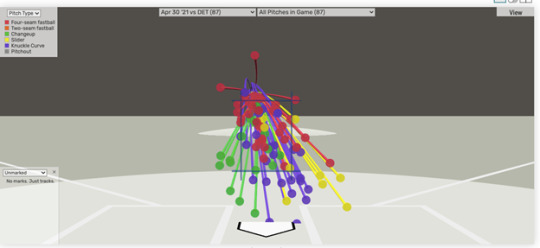
He’s able to keep the fastballs up in the zone and use his change up as essentially a low fastball, but with a 10mph hitters are just really struggling to identify it and do anything with it.
Starting the final game of the series is Jameson Taillon, who’s really been improving his last couple times out. It’s interesting with Jamo that he’s had Gary behind the plate for every one of his starts so far, and also very interesting in that his expected stats are all significantly better than his actual stats: he’s given up seven homers already this season, but if it was park adjusted he’d be expected to give up five homers. His expected ERA is nearly two runs less than his actual ERA. What he’s running into, and why I am not worried about Jamo long term, is this:

To me that screams “this dude hasn’t pitched in two years and is just building up his stamina” more than anything. He’s also been significantly better with an extra day or two of rest, and between him, Kluber, and Severino once he returns from injury, I can definitely see the Yankees try to get them all extra rest when possible.
His slider has easily been his best pitch on the season—.205 wOBA against (.301 xwOBA) with a high spin rate and sitting at 87mph. He’s used mostly that and his four seamer, which has a lot better expected numbers than actual numbers—xSLG of .430 as opposed to actual SLG of .612. That said, when your chart looks like this, it’s easy to see why his SLG is higher than it should be:
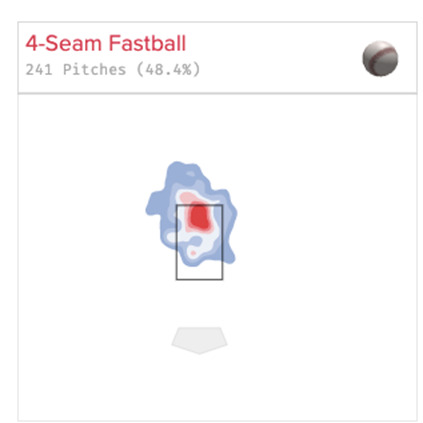
High fastballs are good, but he’s allowing too many high fastballs to be way out of the zone, and they are all really high up. Five of his seven homers are off the 4 seamer, which is totally believable when you look at how his pitches are winding up. A little more time and a little more control can fix that problem however, and I don’t think it’s going to be too long before we see Jamo living up to his potential.
#Yankees#Rays#New York Yankees#Tampa Bay Rays#Series Preview#Gerrit Cole#Jordan Montgomery#Jameson Taillon#Ji-Man Choi#Stop the Trop#Drop the Trop#Flop the Trop#Crop the Trop
1 note
·
View note
Text
Nationals (12-15) at Yankees (16-15)
Note From Evan: Ladies and gentlemen, boys and girls, jabronis and jabronettes, and Yankee fans of all ilk, Sam and I are here to let you know that we now have a third contributor here at Inside the Gift Basket, and this is his first post. Everyone say hi to Julio and from now on you’ll have to bring on more cupcake to class to share with everyone. And with that, onto the good stuff.

Game 1: Friday at 7:05pm EDT on YES and MLBN – Jameson Taillon (1-2, 5.24 ERA) vs. Patrick Corbin (1-3, 8.10 ERA)
Game 2: Saturday at 1:05pm EDT on YES and MLBN – Corey Kluber (2-2, 3.03 ERA) vs. Max Scherzer (2-2, 2.54 ERA)
Game 3: Sunday at 1:05pm EDT on YES and MLBN – Domingo German (2-2, 4.32 ERA) vs. Joe Ross (2-2, 4.39 ERA)
Nationals Injury Report
SP Stephen Strasburg: 10-day IL (shoulder inflammation) – will miss series
RP Wander Suero: 10-day IL (oblique strain) – both he and Strasburg will throw in a simulated game Friday
RP Seth Romero: day-to-day (ribs) – will begin throwing next week
LF Juan Soto: day-to-day (shoulder strain) – should get some at-bats this series, may start at DH
Nationals Pitching
Strong starting pitching was a hallmark of the Nationals during their run of eight straight winning seasons from 2012 to 2019, culminating in a World Series victory the final year of the streak. While their core ace trio of Max Scherzer, Stephen Strasburg, and Patrick Corbin remains intact, only Scherzer of the three has continued to see success in 2020 and 2021, and the starting rotation as a whole has struggled, posting a 4.67 ERA (23rd in MLB). Strasburg has barely pitched as he has been plagued by injuries over the last year and a half.
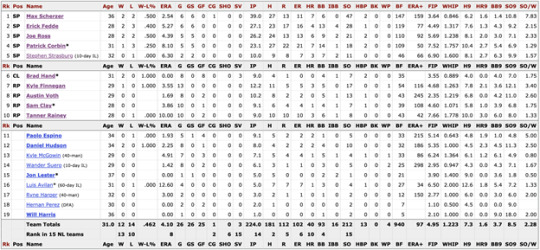
Clay, NY native and childhood Yankees fan Patrick Corbin will pitch the opener opposite Taillon. In 2018 and 2019 Corbin was one of the better pitchers in baseball, finishing 5th and 11th respectively in the NL Cy Young Award race those years while frustrating batters with his trademark tailing-away slider. To say he suffered a World Series hangover may be an understatement:
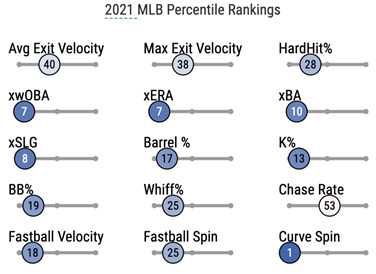
What has gone wrong for Corbin? Even he and Nationals manager Davey Martinez aren’t sure as it doesn’t appear to be a physical or mechanical issue, and his velocity is close to the same as in his 2018-2019 peak.
There are a few possible explanations. One is that he’s lost some spin on his slider (from 2398 rpm in 2019 to 2218 rpm in 2021), and it has gone from one of the best single pitches in the game to basically league average, with opposing batters just not chasing it like they used to:
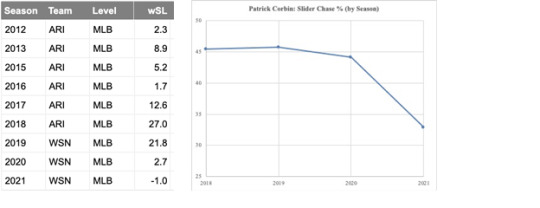
This means that Corbin has fallen behind on counts more than in the past, forcing him to go over the heart of the plate with his sinker to get strikes, and that pitch has been absolutely destroyed this year. It wasn’t a particularly great pitch for him in the past, either, but this year hitters are just teeing off on it (1.091 SLG).
Corbin is not striking guys out like he used to and is giving up hard-hit fly balls at an alarming rate. The average launch angle against his pitches has risen to a career-high 14.7° in 2021, and subsequently he has already allowed 7 home runs in just 23.1 IP. For the sake of comparison, he allowed 15 HR in all of 2018 (200 IP).
There are some encouraging signs as he has looked better lately after a cataclysmic start. He allowed 16 ER in 6.1 IP to the Dodgers and Diamondbacks in his first two starts of the season but has pitched to a 3.18 ERA in three starts (17 IP) since. He hasn’t exactly faced red-hot offenses in that span (Mets, Cardinals, Marlins), and the underlying numbers are still not all that great, but it’s progress.
Max Scherzer will pitch the second game in what could be a very good duel with the surging Corey Kluber. Now in his age 36 season, Scherzer is continuing to put up excellent numbers, and like in recent years, the key to beating him is the long ball. He has allowed a measly 27 hits all year in 39 innings pitched, but 7 of the hits have been homers. He doesn’t walk guys, so the Yankees’ best bet against him is to try to barrel up his occasional mistakes and knock them out of the park.
The finale pits RHP Joe Ross against Domingo German, with both pitchers posting remarkably similar numbers so far this season:

Rather like Corbin, however, Ross’ numbers are inflated by one very bad performance (10 ER allowed to the Cardinals on April 19), and he has pitched well outside of that game. Ross has been a mediocre pitcher most of his career, though, so it’s not like these numbers aren’t indicative of what to expect from him. His slider is his definitive put-away pitch (responsible for 15 of his 21 strikeouts), but his other offerings have been hit hard. He also has a strong platoon split (vs RHH: .241/.287/.394, vs. LHH: .297/.376/.474), so expect the Yankees to give most of their available lefty hitters a start in the series finale.
While the rotation has been disappointing, the Nationals’ pen has been a strength for the team in the early going. Washington relievers own a league-best .185 batting average against, admittedly aided by one of the better defenses in the league (league-leading 24 DRS), and offseason acquisition Brad Hand has been a stabilizing force at the back of games, having yet to allow an earned run this year.
Daniel Hudson, Austin Voth, Sam Clay, and Wander Suero (who is likely going to miss this series) have all posted solid numbers behind him, and their most-used reliever, Kyle Finnegan, threw an immaculate inning in their just-completed series with the Braves. Ex-Astro Will Harris was recently activated off the IL and has very good career numbers, though the Yankees have hit him well historically.
The one major blip is Tanner Rainey, who was one of their most important relievers the last two years but has struggled mightily so far this season. He is likely to be limited to low-leverage action until he gets his act together.
Nationals Lineup
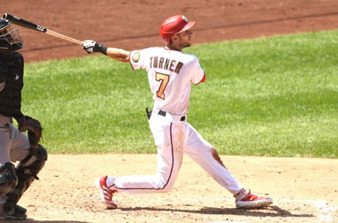
A consistently strong offensive team during their 2010’s run, peaking in 2017 when they led the NL in team OPS, the Nationals have had to weather the departure of important contributors like Bryce Harper and Anthony Rendon in recent years. While they still have a few dependably great hitters in the lineup, their offensive output in 2021 has been, at best, mediocre:
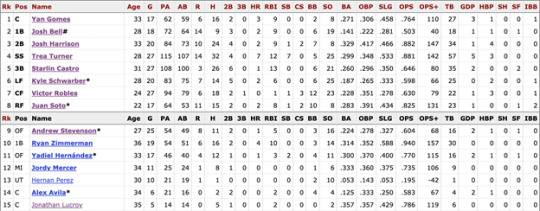
As a team they get a lot of hits (for 2021 standards, anyway), as their .247 batting average somehow actually leads the National League. However, they rarely draw walks and have not hit for power so far this year (outside of Trea Turner), resulting in a poor .696 team OPS and a marked difficulty putting up runs – they have yet to score more than 7 runs in any game this season and have been shut out five times. They are coming off a three-game sweep at home at the hands of the Braves in which they only scored six runs.
With Juan Soto battling a shoulder injury, Trea Turner has been their most important and all-around best position player:

While his numbers are a bit down from an outstanding 2020 (163 OPS+) that saw him finish 7th in the NL MVP race, he hits the ball hard to all fields, runs like the wind, and is a plus defender at shortstop. He has been a top 20 player in baseball this year in both bWAR and fWAR.
Antoher bright spot has been Josh Harrison, who signed with the Nationals as a reclamation project after seemingly forgetting how to hit sometime between 2018 and 2019; he has just about revived his career and been one of the team’s best hitters. The same cannot be said for his longtime Pirates teammate Josh Bell, who has been a nonfactor at the plate. While the Nats have been giving him (and the also-struggling Kyle Schwarber) plenty of opportunities to snap out of it, expect them to give more playing time to the hot-hitting Ryan Zimmerman at first base moving forward.
Lastly, keep an eye out for young phenom Juan Soto – he just came off the IL from a shoulder injury and pinch-hit a few times in the Braves series. According to the Nationals, he is ready to start hitting every day, but they are reluctant to let him play the field as his shoulder is not yet fully recovered and he should not be making throws. Luckily for them they are playing in an AL park this weekend, so he may get some starts at DH against the Yankees (which is, of course, bad news for us).
Yankees focus on: Wandy Peralta
LHP “Magic” Wandy Peralta came over from San Francisco (along with a PTBNL) in exchange for beloved backup OF Mike Tauchman, much to the chagrin of certain Yankees fans. Now in his 6th season, the 29 year-old Peralta has, on the surface, been largely unremarkable as a major leaguer to date, with a career 4.66 ERA and 1.477 WHIP. While he is coming off a solid 2020 in which he posted a career-best 3.29 ERA, he struggled to start this season in San Francisco and fell out of Gabe Kapler’s Circle of Trust™.
The raw numbers don’t jump out at you, but clearly the Yankees viewed Peralta as an interesting piece if they were willing to go so far as to part with Tauchman for him. After a bit of digging, it’s not hard to see why they found him appealing:

The underlying metrics have been impressive. In fact, his stuff has looked much better so far this year than it did in 2020, despite posting better standard stats last year.
It may be a microscopic sample size, but Peralta has looked promising in his first few appearances with the Yankees. The coaching staff has encouraged him to spam his wipeout changeup, to great effect:

While he has lost command of the changeup at times earlier in his career, it’s an incredible pitch when he’s throwing it well. So far this season: xBA of .109, xSLG of .133, and a -3 launch angle.
Last year his slider was a very good pitch, but this year it hasn’t been as effective, thus the Yankees have responded by ramping up his changeup usage and cutting back on the slider. In an ideal world, Peralta can learn to use them both effectively to pair with his plus heater. The raw stuff is there, and it always has been; the hope is that the Yankees’ coaching staff can get Peralta to harness his talent and potential.
With Tauchman playing well in San Francisco to this point and providing much-needed support for their banged-up outfield, this could be a trade that proves to be a win-win for both teams involved.
#Yankees#New York Yankees#Nationals#Washington Nationals#Baseball#MLB#Series Preview#Interleague Play#Natinals#Juan Soto#Trea Turner#Wandy Peralta#Everyone Say Hi to Julio
4 notes
·
View notes
Text
Houston Astros (15-13) at New York Yankees (14-14)
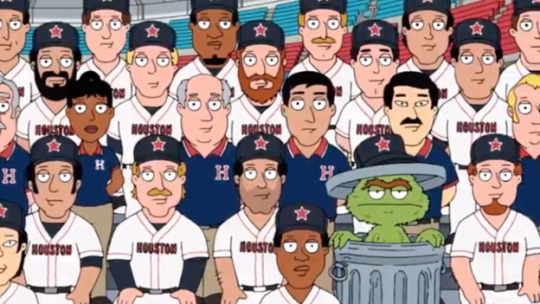
Game One – Tuesday, May 4th at 705pm on YES and ESPN: Zack Greinke (2-1, 3.44 ERA) vs Domingo German (2-2, 4.05 ERA)
Game Two – Wednesday, May 5th at 705pm on YES: Luis Garcia (0-3, 2.70 ERA) vs Jordan Montgomery (1-1, 4.39 ERA)
Game Three – Thursday, May 6th at 105pm on YES and MLBN: Lance McCullers Jr. (2-1, 3.38 ERA) vs Gerrit Cole (4-1, 1.43 ERA)
Astros Injury Report
SP Justin Verlander – 60 Day IL, out for season after Tommy John surgery
RP Josh James – 10 Day IL, out until June after hip surgery in October
SP Framber Valdez – 10 Day IL, no timetable to return after broken finger
RP Enoli Paredes – 10 Day IL, no timetable to return after oblique injury
RP Blake Taylor – 10 Day IL, no timetable to return after sprained ankle
SP Jake Odorizzi – 10 Day IL, no timetable to return after strained forearm
RP Austin Pruitt – 60 Day IL, no timetable to return after surgery to fix broken elbow
RP Pedro Baez – 60 Day IL, no timetable to return after shoulder discomfort
Astros Pitching
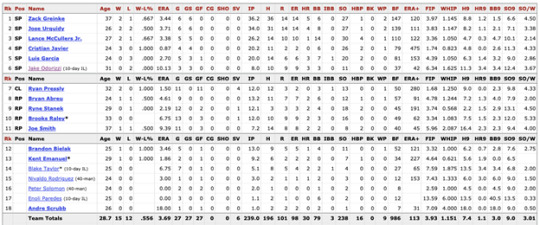
The Astros and their “Just Throw Harder” philosophy where they take older pitchers and magically have them throw 5mph harder than they did previously come to town this week, and their pitching has actually been pretty solid. Not having Justin “Cheaters on other teams are the devil but if they’re my teammate no comment” Verlander this season is obviously hurting them, and losing both Odorizzi and Framber Valdez due to injury hasn’t helped either, but the guys they have left have been really solid. The Astros as a team rank 10th in ERA (3.69 runs per game), 8th in WHIP (1.51), 9th in hits per game (7.4), 11th in homers allowed per game (1.1), and 12th in walks per game (3.01). The one below average category they have is strikeouts per game (16th, at 9 per game). Outside of losing 9 out of 10 games to the A’s, Tigers, Mariners, and Rockies, they have looked really solid this year.
Starting the first game for the Astros is the 37 year old former Cy Young winner Zack Greinke. Greinke is still just chugging along—he’s throwing a 4 seam fastball that sits at 88mph with no movement that’s become an extremely hittable pitch, but he combines that with a nasty changeup (averaging 86mph but with 31 inches of drop to it, it acts more like a splitter), and the same Uncle Charlie he’s always thrown—71mph with 66 inches of drop to it. He throws those three pitches to both righties and lefties, but against righties he will mix in a pretty bad sinker and a wipeout slider with 50% more horizontal break than the average one.

Really it’s that four seam fastball that you wanna tee off on, it’s a pitch he throws significantly more when he’s behind in the count as opposed to the change up/curve that he uses as an out pitch:

Partially because he throws so slow, and partially because he throws a bunch of junk, Greinke is in the 92nd percentile in average exit velocity allowed. He’s also once again in the 90% percentile for walk rate. That said, he is vulnerable to giving up barrels (27th percentile this year would be his best in the Statcast era) and he is only in the 19th percentile in K% and 20th percentile in whiff rate. If a team happened to have, for example, Giancarlo Stanton and Aaron Judge who could create their own exit velocity, he could get torched. In his career, Greinke has allowed his second highest OPS to the Yankees at .746 (only the Angels have a better career OPS against him at .747). That’s in 15 starts, going 4-4 with a 5.05 ERA not including his duds in the 2019 Postseason against New York.
Greinke also has reverse splits—righties are hitting .260/.269/.468 with 4 homers, 4 doubles, 0 walks, and 13 strike outs in 78 PA as opposed to lefties hitting .258/.319/.387 with 1 homer, 5 doubles, 6 walks, and 14 strikeouts.
Starting Game Two is Luis Garcia, still a prospect for the Astros and still looking for his first MLB win. He’s been used as a swingman for them the last couple years, and hasn't pitched more than 84 pitches or gone longer than 5.2 innings for them (he’s averaging around 4 innings an appearance currently.) Garcia has a mid 90s fastball that he likes to pump the zone with, and then a few other pitches he struggles to command- a nasty 80mph slider with a ton of horizontal break (78% more than average), a 87mph cutter than has 84% more horizontal break than the average cutter, and then a 83mph changeup that’s a batting practice pitch.

He keeps that cutter off the plate but because of the elite movement on it, it’s able to get a lot of whiffs and a lot of weak contact at guys thinking it’s going to be a strike. He uses the 4 seam equally against lefties and righties, but the slider and cutter are righties only and the change is lefties only. As you might expect because of this, he is super platoon friendly: righties are slashing .129/.206/.194 and lefties are slashing .250/.355/.596 in his career. He’s also been a guy with low exit velocity allowed, partially because his average launch angle this year is 22.6 degrees, but he also walks a lot of guys and gives up a lot of extra base hits. This would be a perfect game to get some lefties in the lineup and to tell the righties to try and reach the short porch, because he’s a 36.5% fly ball pitcher (highest of the four batted ball types) and gives up 36.5% of his hits to the opposite field (more than he does to pull or center field).
Starting Game Three is Lance McCullers Jr., fresh off a 5 year, $85m extension this offseason. He missed all of the 2019 season due to Tommy John surgery, but his last two appearances vs the Yankees in 2018 and 2017 he did do pretty well—in 2018 he pitched 7 innings and gave up 3 runs in a loss, and in 2017 he closed out Game 7 of the ALCS by going 4 shutout innings before the team cheated to win the World Series.
McCullers is back to being what he was before getting TJS- a pretty good #3 pitcher with one really nasty pitch and then a few hittable pitches. His curveball is his famous pitch- an 84mph knuckle curve with elite spin, but this year he’s started to throw a slider as well. The curve is now being used exclusively against lefties, and his wipeout slider with 7.8 extra inches of horizontal break vs average is being used against righties. Both of those pitches are generating a lot of weak contact and a lot of swings and misses, which is good for him because his sinker and cutter are getting lit up: over 50% hard hit rate on both of those pitches which puts him in the 28th percentile in average exit velocity. He’s also walking a ton of guys (12.7% of batters get walked, 20th percentile) and when you combine those you can get into a sticky situation.

Lefties are just going to have to really just spit on stuff down and away and take advantage of any mistakes he leaves over the plate. He hasn’t allowed a single extra base hit to a righty so far this year, but his expected stats say people should be slugging better than they currently are.
The Astros bullpen is currently 15th in ERA, which is rather impressive considering how many bullpen pieces they’re missing, but it’s really been carried on the backs of two guys—Ryan Pressly and Ryne Stanek. Pressly is 2-0 with 4 saves and a 1.50 ERA in 12 innings (280 ERA+) and Stanek is 0-1 with a 2.19 ERA in 12.1 innings (191 ERA+). Pressly has been one of the best relievers year after year for a while now, mixing in weak contact with a huge differential in his K%-BB% (striking out 26% of batter and only walking 6% this year) thanks to a mid-90’s fastball and two nasty breaking balls, and Stanek is mixing a high 90s fastball with a high 80s splitter to strike out over 40% of batters he’s faced this year. The goal for the Yankees is to beat up on the other guys in their pen and not have to face those two with the game on the line.
Astros Lineup

Offensively, the Astros are being carried by the middle of their lineup—Gurriel, Correa, Bregman, Brantley,and Alvarez have all been great this season. Altuve is back to putting the ball in play consistently, although it’s kind of strange that he has stopped being able to drive the ball since the 2019 season ended, I’m not sure if there’s a reason why to that? Houston is sixth in OPS+, and are fourth in batting average as a team, second in doubles, and the third lowest in strikeouts. That said, they’re 22nd in walks and tied for 23rd in homers, so they’re putting the ball in play a lot and the Yankees defense is going to need to be sharp to limit them offensively.
Carlos Correa has chosen a good time to be healthy and to start hammering the ball all over the place again:
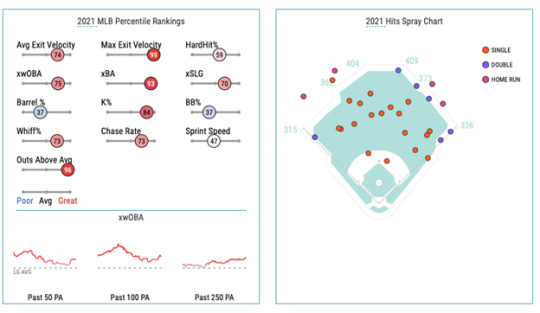
He’s a free agent after this season, and he’s really hitting the ball hard and doing a good job of not missing pitches—he’s been worth 1.6 bWAR which is tied for fourth in the AL with Vlad Jr., and he’s getting a lot of doubles this year to go with the four homers.
Yordan Alvarez, after missing most of the 2020 season, is back, and is doing something you don’t normally see from a big lefty DH:

He’s only pulling the ball 22.8% of the time, and it’s leading to his wOBA against being shifted being .366 vs his wOBA with no shift being .306. Now part of me wonders if they’d prefer he didn’t go oppo that much, because he’s not hitting extra base hits like he did at a record pace en route to being the 2019 AL Rookie of the Year, but it’s hard to argue with his current approach.
That said, the Astros’ offensive MVP has been nowhere to be seen since the end of the 2019 season and it’s just so weird how after said trash can has been gone guys like Jose Altuve have stopped hitting breaking pitches.
Altuve against breaking balls from 2017-2019- .334 batting average. Altuve against breaking balls since being found out to be a cheating scumbag—.165 batting average. Turns out it’s a lot harder to hit when you don’t know what’s coming!
Yankees Focus On: Aaron Judge
Oh yeah, the guy that should have been the 2017 MVP even before the cheating scandal broke is once again putting up monster numbers.

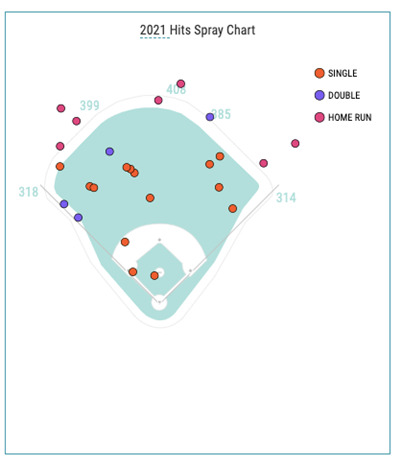
That’s elite exit velocity and elite numbers being spread all over the field, and that’s with him not getting pitches to hit for half the season. He’s in the 40th percentile in K%, but those numbers have sharply declined over the years (it’s down 6% from his 2017 record breaking season!) He’s hitting really well against righties (.266/.365/.516) but is destroying lefties (.364/.481/.773) which is too bad that Houston won’t be using any lefties this series.
Judge moving to the three hole has made a huge difference for the team offensively: on April 26th, Judge was hitting .105/.346/.158 in the three hole vs .300/.375/.560 in the two hole. After they made the move to put Gio in cleanup, he’s now up to .233/.410/.600 with 3 homers and 7 RBI in the three spot. It’s also really freed up Giancarlo- Judge’s protection is allowing Stanton to slash .375/.388/.604 with 3 homers and 8 rbi in the two spot instead of .171/.277/.415 as the cleanup hitter. Obviously walks are super helpful and can win you games, but the bat was being taken out of Judge’s hands before Gio moved up the order to ensure Judge would get pitches to hit, and now he’s punishing teams for it.
Also, Judge is getting into a full count in 23% of his plate appearances this season, and is slashing .333/.565/.867 in full counts this year. Outside of taking things easy in right field this year, he might be putting up his best season as a pro yet.
#Yankees#New York Yankees#Asterisks#houston asteris#MLB#Baseball#Trash Cans#Oscar the Grouch has more dignity#cheaters#2017 AL MVP#fake world series#altuve is a baby#correa is fake tough#bregman makes Evan ashamed of being Jewish
0 notes
Text
Yankees Minor League Assignments Part Four
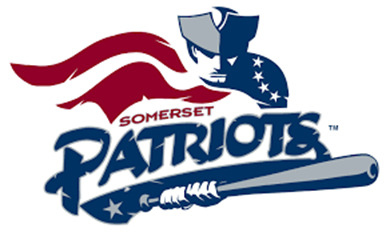
Somerset, the new Yankees AA affiliate, plays in TD Bank Ballpark in Somerset, NJ. Previous in the Atlantic League, the Patriots took over the AA role from the Trenton Thunder starting in the 2021 season.
Players to Watch:
Luis Gil, RHP (#5 Yankees Prospect)
Gil, who the Yankees received in a trade with the Twins for Jake Cave, has a really good pitch mix and some great stuff. As a starter, he sits in the mid 90’s and can touch triple digits with movement on his fastball, he can also add in a hard changeup with sink and a wipeout slider that it’s in the high 80s. He does struggle to find the strike zone, and although he’s lowered his walk rate every year in the minors, it does keep him from going deeper into games. While the Yankees may prefer to give him another chance to be a starter, he could make a legitimate reliever as soon as this fall for the Yankees. He threw two perfect innings with three strikeouts in Spring Training for the Bombers and if he’s not up as a reliever this year, would likely see time with the team next year if he’s not traded.
youtube
Glenn Otto, RHP (#28 Yankees Prospect)
The Yankees drafted Otto in the fifth round of the 2017 draft, where he was an elite reliever at Rice, but the Yankees tried moving him back into the rotation. As a starting pitcher, he’s put up some pretty good numbers when he’s been healthy, but between injuries and not really being a starter he’s barely pitched any innings (91. IP in four minor league seasons) and is likely going to head back to the bullpen.
youtube
He has a very violent delivery which would really worry me if he tried to be a starter long term, and only has two pitches (that admittedly, are very good)—a fastball that sits in the low 90s as a starter but is around 98 mph with movement as a reliever, and a spike curveball in the low 80s. Best case scenario for Otto is that he ends up similar to Chad Green- a two pitch guy who can give you an effective inning or two out of the bullpen.
Dermis Garcia, 1b/3b (Unranked)
Dermis isn’t really a highly regarded prospect anymore, but I like him and even though I have zero faith he’ll ever actually be good, there is still a chance he can put it together and put up some monster numbers. Garcia is a righty bopper who doesn’t do a lot of bopping because of his high strikeout numbers and lack of contact, but he does have some of the best raw power of anyone in the minors, not just the Yankees system. He’s been Rule 5 eligible for a while, so if he starts to put up some numbers then the Yankees would likely have to add him to the 40 Man, but there’s still a chance that he could be a MLB level masher, even if it’s more likely he never makes it to the bigs.
youtube
Hoy Jun Park, SS (Unranked)
I don’t personally see it with Park, but the Yankees did invite him to Spring Training and gave him some at bats (he went 0-7 with four walks this spring.) He’s an average defensive shortstop with below average power, but he does have a good contact ability and can earn walks. His best chance is to get traded elsewhere and try to get a backup infielder job.
youtube
Estevan Florial, OF (#10 Yankees Prospect)
While it’s somewhat surprising to see Florial starting in AA instead of SWB, outside of one game played for the Yankees last summer due to injury, he hasn’t played a game above High A. Florial is a pretty fun prospect- is an elite defensive outfielder with plus speed, plus plus arm, and plus plus range and fielding acumen, and would be the best defensive player on the Yankees if he got called up today. His issue is at the plate- he has the ability to crush some homers and could be a 30/30 guy if he reaches his peak, but he swings his bat like an oar and misses the ball a lot.
youtube
The obvious comparison is Curtis Granderson- another lefty CF who had some power and a lot of strikeouts, and unfortunately for Florial unless he completely revamps his swing, he’s going to deal with the strikeout issue forever. That said, he’ll always have a role in the Majors if only because of his defense—you can live with him hitting in the low .200s with some bombs and elite defense as a fourth outfielder.
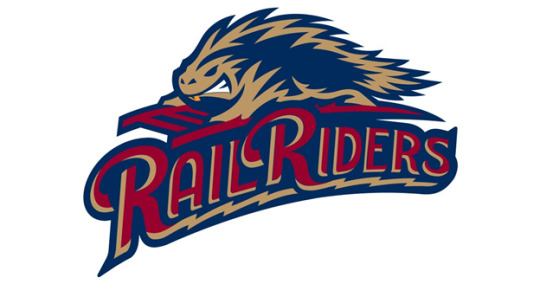
The Yankees’ Triple A affiliate is once again the Scranton/Wilkes-Barre RailRiders, as they have been every year since 2007. They play at PNC Field in Moosic, PA, which is the second best offensive park in the International League. The Yankees have loaded the RailRiders with a bunch of AAAA talent and not a lot of individual prospects, so instead of going player by player I’ll be going position group by position group for SWB.
Pitchers
Deivi Garcia is the obvious name for the ace of the rotation, and as Yankees fans know he has some high end upside and will be featured on the main roster again at some point this season. Clarke Schmidt will be in SWB once he’s finished rehabbing his elbow injury, and also is likely to get promoted during the season. Brian Keller has had some success in the minors for the Yankees, but his stuff isn’t that great and he projects as a swingman at best in the majors. Mike Montgomery is likely the #2 starter for SWB, he’s a 32 year old with MLB experience. If things really go off the rails for the Yankees, he’d likely be called up before Medina/Gil/etc. despite not being on the 40 Man. He has bad stuff but can eat innings and has an okay change up.
For relievers, there are a lot of options: Nick Nelson has obviously seen a lot of opportunities over the past two seasons in New York, and has shown some encouraging signs and some really bad ones. Brooks Kriske has also had some chances on the main roster, but has shown zero encouraging signs. He is on the 40 Man and could be up again this season, but is the most likely player to get DFA’d at this point in the organization. Albert Abreu has some nasty stuff and can reach triple digits on his fastball, but also can’t find the strike zone. For non-40 Man options, Kyle Barraclough has had some serious MLB success his first few years in Miami, but has been beyond awful since. He went from un-hittable to extremely hittable after losing life on his pitches (his fastball velocity went down about 4mph in two years.) Braden Bristo hasn’t really gotten a lot of buzz or chances, but some scouts have talked about his high RPM curveball and good fastball. Old favorite Nestor Cortes Jr. is back in SWB, and while he hasn’t been good outside of his one (actually not that good) season in the Bronx, he’s still a fan favorite and a lefty reliever who can give you some length. Nick Goody has MLB experience and an okay slider, but he doesn’t get a lot of strikeouts and walks too many people to be a reliable option. Trevor Lane is an intriguing option, his stuff is just okay but he can give you multiple innings out of relief and averages a strikeout an inning out of the pen. Addison Russ was acquired in the David Hale trade last summer with the Phillies, and had a power fastball and a good splitter. Adam Warren is coming off (another) injury, but is a reliable multi-inning guy who the Yankees can trust.
Catchers
Neither catcher is on the 40 Man, so if something happened to Higgy or Sanchez they would need to be added, but there are two potential options in SWB. Rob Brantly has been around a really long time and played in parts of six MLB seasons since 2012, but put up good numbers in Spring Training. He’s a pull hitter and an okay defensive catcher as a 32 year old journeyman. Robinson Chirinos had spent most of his career in Texas (outside of coming up with the Rays and a brief spell with the Astros and Mets) and despite having a mediocre hitting career, has been a decent defensive catcher and calls a good game.
Infielders
Chris Gittens will be splitting time at 1b/DH with Mike Ford once Ford is sent back down. Gittens is entering his age 27 season and can really crush the ball, but strikes out a ton. There is a chance that he’s Luke Voit 2.0 and is just needs an opportunity, but there’s also a chance he’s a AAAA player. Derek Dietrich is the king of swag and can crush pitches and draw walks as a 2b/3b, but outside of that doesn’t do a whole lot. Kyle Holder was selected by the Reds in the Rule 5 draft but was given back to the Yankees- he’s a glove first infielder who’s just average as a defender and is awful at the plate. Andrew Velazquez has played for Tampa, Cleveland, and Baltimore in the majors since 2018 and can give you bad offense at five different positions. Armando Alvarez has been in the Yankees system since 2013 as an 18 year old, and put together a nice AAAA career for himself at 1b/3b. The only player on the 40 Man is Miguel Andujar, who is healthy after a wrist injury in spring training. He’s been getting a little work in at 1b, likely because the Andujar in the OF plan didn’t work out and the Yankees need to find someone who believes in him to trade him.
Outfielders
None of our outfielders in AAA are currently on the 40 Man, but there is certainly a chance we’ll need to call one of these guys up this season. Greg Allen was DFA’d by the Yankees in spring but stayed with the organization, he’s a good defensive outfielder with some speed and no hitting ability. Socrates Brito can play all three outfield spots but hasn’t hit since 2015. Ryan LaMarre has good platoon numbers against left handed pitching, which is awesome other than the fact that the Yankees have a ton of righties already. Trey Amburgey has spent his career in the Yankees minor league system but started to show some pop in the 2019 season (22 homers) and has made incremental improvements ever year.
#Yankees#New York Yankees#Somerset Patriots#Scranton/Wilkes-Barre Railriders#Prospects#Baseball#Minor League Baseball
1 note
·
View note
Text
Yankees Minor League Assignments Part Three
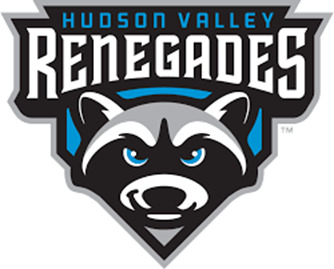
Hudson Valley is the new High A affiliate for the Yankees, with Tampa dropping to Low A and theYankees no longer affiliated with Charleston. Playing at Duchess Field in Wappingers Falls, NY, the Renegades had previously been in the New York-Penn League.
Players to Watch:
Luis Medina, RHP (#7 Yankees Prospect)
The legend of Luis Medina grew this winter as he took the Puerto Rican Winter League by storm. Before 2020, Medina was a huge wild card in the Yankees organization- he really struggled to find the zone but had insanely good stuff, but between being at the Alternate Site in 2020 and his domination of Liga PR, he’s now become one of the must see Yankee prospects. In Liga PR, Medina won the Pitcher of the Year award after striking out 32 hitters (with just six walks) in sixteen innings and just blew away hitters significantly older than him (Medina is still just 21 years old.)
youtube
If the improved command is true, and if Medina stays healthy, he has legitimate Cy Young contender ability- he sits in the high 90s (with movement!) with his fastball, he has an unreal hammer curve, has an elite change up that sits around 90 mph with nasty drop, and he has a smooth and easily repeatable delivery. Outside of Jasson Dominguez (and maybe even including him) he has more upside than anyone in the organization, but he also has a legitimate chance of never making it to the majors if he loses the zone again.
Josh Breaux, C (#19 Yankees Prospect)
Think of all the pros and cons of Gary Sanchez—potential elite hitting, major power from the catcher position, great cannon arm, huge strikeout risk, injury problems, and poor receiving. Have you enjoyed the Gary experience? Well, Josh Breaux is just the second coming of Gary with all the same promising things and same problems. He’s been dealing with elbow problems since he was in high school, and if he can’t stick behind the plate then I’m not sure he’s a consistent MLB starter.
youtube
Anthony Seigler, C (#22 Yankees Prospect)
Seigler has had a ton of injury problems in the minors (concussion, hamstring issues, fractured patella, quadriceps issues) since being drafted in 2018, but he’s a different kind of catcher than what the Yankees usually prefer. Seigler is an elite defensive catching prospect, but as a switch hitter he has excellent contact skills without any power whatsoever. He’s also more mobile than you’d usually see from a catcher and can earn some walks, and I’m pretty confident that if he stays healthy that he’ll have a long career as a backup catcher. That said, if he ever wants to be more than that, he’ll need to actually hit the ball in the air and do better than six extra base hits in 176 plate appearances.
youtube
Ezequiel Duran, 2b (#15 Yankees Prospect)
Duran is entering into a very important year with the Yankees, as he is Rule 5 eligible after this season. He gets compared to Dan Uggla a lot, and the comparison does make a lot of sense—Duran is a mediocre defensive player with a high strikeout rate, but can really hit the ball hard and do some damage at the plate that way. He got some opportunities in Spring Training, so the team either believes in him or is showcasing him for potential trade targets, and starting the season off in High A is a good start at least.
youtube
Oswald Peraza, SS (#4 Yankees Prospect)
Peraza is a Top 100 prospect in all of baseball, and the best Yankees position player prospect starting the season in the minors. He turns 21 this year and is already on the 40 Man, and he has an excellent set of tools at his disposal—has great contact skills, good defensive skills, elite speed at shortstop, and has started to add a little power to his game as well. Even if he doesn’t become a significant power threat, Peraza has future starter written all over him, but if he can turn his doubles into homers then he’s a potential All Star.
1 note
·
View note
Text
Yankees Minor League Assignments Part Two
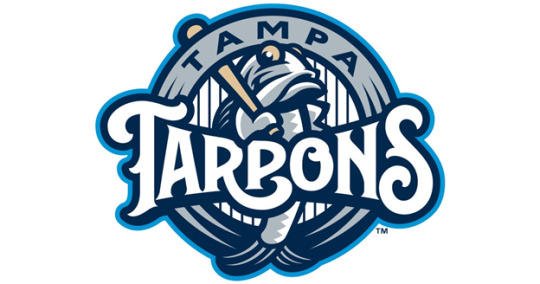
Tampa is now the Low A minor league affiliate for the Yankees, after previously being the High A affiliate, and begin their season on May 4th against the Dunedin Blue Jays. They play in GMS Field, where the Yankees play their Spring Training games, which has a slightly above average offensive park factor.
Players to Watch:
Matt Sauer, RHP (#26 Yankees Prospect)
Sauer was drafted in the second round of the 2017 MLB Draft, but is coming off Tommy John surgery in 2019. He was able to get a little bit of work in the minors in both Stanton Island and Charleston in 2018 and 2019 (before his injury) and is someone who has a lot of potential with his stuff, but a lot of injury risk.
youtube
As you can see, his delivery is pretty violent and is obviously worrisome when it comes to more potential injuries down the road, as well as causing potential inconsistencies with his command. That said, the risk might be worth it, as he has a mid 90s fastball as a starter with a plus plus hammer curveball and an improving change up, and reportedly was pitching in the high 90s in a bullpen session last year during the pandemic. He’s still just 22 and despite being Rule 5 eligible this winter, he’s someone I would project the Yankees to hold on to on the 40 Man. Sauer will likely get plenty of opportunities to showcase his ability to be a starting pitcher, but he does have the potential to be a back end reliever if he can’t make it as a starter.
Austin Wells, C (#6 Yankees Prospect)
Wells, the Yankees 2020 First Round pick, has already gotten some at bats in Spring Training, and the coaching staff spent a ton of time this March raving about him. While a lot of scouts have suggested he’s most likely to end up as an outfielder or first baseman (similar to Kyle Schwarber), the Yankees seemingly believe in his ability to be a catcher long term. Wells sticking to catcher would mean he would have higher upside, but it also means he’ll take a little longer to make it to the majors than if he did get moved to a different position. Wells is a lefty with really good hitting projections—55 hit tool and 55 power tool from Fangraphs to go along with really good pitch recognition skills. It wouldn’t be insane to see him slash .275/.350/.450 as a lefty and be able to take advantage of the short porch, but he also can spread the ball across the field. Austin’s big issue is defensively, where in college he was a below average receiver and struggled with his arm strength after getting surgery, but Tanner Swanson has said he’s improved majorly in both spots.
youtube
Trevor Hauver, 2b (#23 Yankees Prospect)
Hauver was the Yankees’ third round draft pick last year from Arizona State, and like Wells, he’s a lefty who can really hit but has concerns defensively. However, unlike Wells, there are legitimate concerns about whether Hauver can even be a passable position player in the field and doesn’t have nearly the same offensive skills as Wells. Trevor is similar to Derek Dietrich in that he has a swagger to him, can work the count, and as a lefty can really pull the ball and do some damage, but he’s not a contact guy (40 grade at Fangraphs) and the hope is defensively he’ll be a slightly below average defender. Hauver has previously gotten comparisons to Daniel Murphy on the high end and Rob Refsnyder on the low end.
youtube
Anthony Volpe, SS (#11 Yankees Prospect)
Anthony is a local product who was high school teammates with Jack Leiter, and the Yankees took him in the first round in the 2019 draft. He’s someone who, despite being 5’11”, has plus plus defensive potential at shortstop—average range, but great fielding, arm, and speed tools. He also has the ability to spread the ball across the field and has good contact skills, but likely won’t be a big time power threat as he has more doubles strength than home run strength currently. For a player comparison, he’s gotten compared to Jose Iglesias, which would be a pretty useful player for the Yankees.
youtube
1 note
·
View note
Text
Yankees Minor League Assignment Breakdown

Extended Spring Training/Not Assigned Guys
For those not aware, extended spring training is typically reserved for players who haven’t played organized ball yet, or guys that are coming off an injury. In a normal year, extended spring training typically goes from the beginning of April to mid-June, when the players would then go to rookie ball. However, with the pandemic and the reduction of minor league teams this year, I’m not sure how long they’ll be kept there or if everyone would get promoted eventually. In extended spring, the games are typically not publicized and are a little more loose with the rules, and mostly meant for development, but there will be some scouts that’ll go to games and we’ll get to see at least SOME footage of these guys.
Also included in this list are players who are not assigned to any minor league team, which could mean that instead of going there for development, they could be rehabbing an injury.
Jasson Dominguez, OF (#1 Yankees Prospect)
Everyone at this point has heard the buzz about Jasson—despite early reports that he was going to be assigned to High-A Hudson Valley (which would have been ludicrous) he’s starting in extended spring training. Five tool player who’s getting insane comparisons to Mickey Mantle, Jasson will get his feet wet and we’ll all finally get to see if he’s more than just a batting practice monster.
youtube
Yoendrys Gomez, RHP (#8 Yankees Prospect)
Gomez not being assigned is worrisome for two reasons—he’s already pitched in A ball, already pitched in MLB Spring Training this season, and is on the 40 Man already. This means the 21 year old either really declined over the past year and a half, or is more likely dealing with some sort of injury. Gomez is famous for his nasty curveball, but also has a mid 90’s fastball and a decent change up, and has pretty good command for someone his age and with his lack of experience.
Alexander Vizcaino, RHP (#9 Yankees Prospect)
Vizcaino is in the same boat as Gomez—already pitched in the minors, already on the 40 Man- but he didn’t pitch in Spring Training this year and turns 24 this month. He already projected more as a reliever, but the fact that he’s not assigned to a MILB team at his age and lack of experience means he’s even more likely to get forced in that role or traded. Vizcaino is a ground ball machine, with a sinking fastball and the best changeup in the Yankees organization, but struggles to get swing and misses and doesn’t have a good breaking ball yet.
Kevin Alcantara, OF (#12 Yankees Prospect)
Dominguez gets a lot of hype (and deservingly so) but a lot of scouts rave about Alcantara as a prospect as well- he’s a 6’6” outfielder who turns 19 this year, and has the frame and ability to be someone who crushes bombs while playing elite defense in the corner outfield. The Yankees have also really been impressed with his work ethic and his baseball IQ, and the main issue that scouts have noticed with him is he has an issue with whiffs, but that seems to be more of a barrel accuracy issue as opposed to a serious concern. There is a legitimate chance that both Kevin and Jasson end up patrolling the outfield in the Bronx by 2025.
youtube
Alexander Vargas, SS (#13 Yankees Prospect)
Vargas is someone that has a LOT of upside but also a lot of potential risk—he’s a 6’ shortstop that turns 20 this year, and he projects to be a really good defensive player. The Yankees signed Vargas using the money they got in the Chasen Shreve and Gio Gallegos trade, so it might not just be Luke Voit for the return. He has a good hit tool (55 grade from MLB Pipeline) to go along with plus base running, plus fielding, and a plus arm, but due to his lack of strength (155 pounds at 6 feet) has a hard time putting any juice on the ball. He is a switch hitter which always helps, but believing in him becoming more than a AAAA player means you have to believe in him adding some muscle and being able to actually drive the ball. If he does that, then he may have future All Star upside.
youtube
Josh Smith, SS (#14 Yankees Prospect)
Smith is listed as a shortstop, but he’s really a future utility player in all likelihood. Smith was an awesome player at LSU, but he’s really more of a jack of all trades, master of none prospect. He’s already 23 and hasn’t made it to Low A yet, so he’s already a couple years older than his peers, but if he can live up to his potential you’re looking at a guy with good bat to ball skills and capable enough defense anywhere in the infield and potentially the outfield.
youtube
TJ Sikkema, LHP (#16 Yankees Prospect)
A left handed pitching prospect for the Yankees is super rare, and the Yankees spent a first round pick on him in 2019 after dominating at Missouri. He’s got good command over his pitches (currently a low 90s heater, a good change up, and a slider) and is able to tunnel all three pitches well. He doesn’t have a ton of high end upside, but he does have a seemingly high floor as a swingman or fourth/fifth starter and could move up the ranks pretty quickly as a starter.
youtube
Everson Pereira, OF (#17 Yankees Prospect)
Pereira is the third of the Yankees trio of good outfield prospects that’ll be in Extended Spring Training—he’s already had a taste of minor league ball and played in the Appalachian League as a 17 year old. Projecting more as a corner outfielder, Pereira went from a prospect with good fielding and decent speed who had the potential for high contact rates to someone who struck out a lot in his first pro games (33% strikeout rate) after putting on some muscle and trying to generate more power. He is still really young, but with other outfielders in the system he’s going to need to start producing or he’s trade bait as he is Rule 5 eligible this offseason.
1 note
·
View note